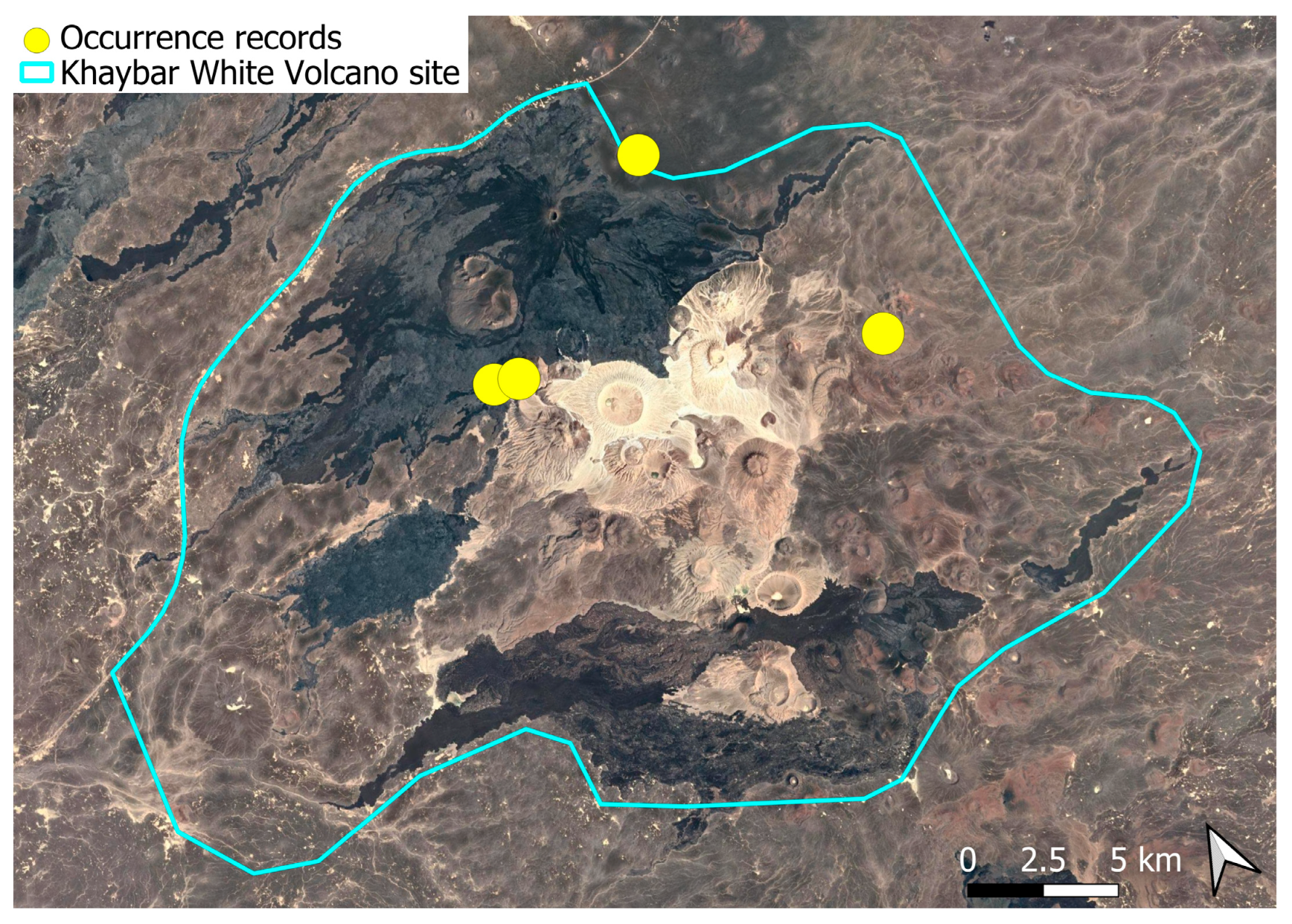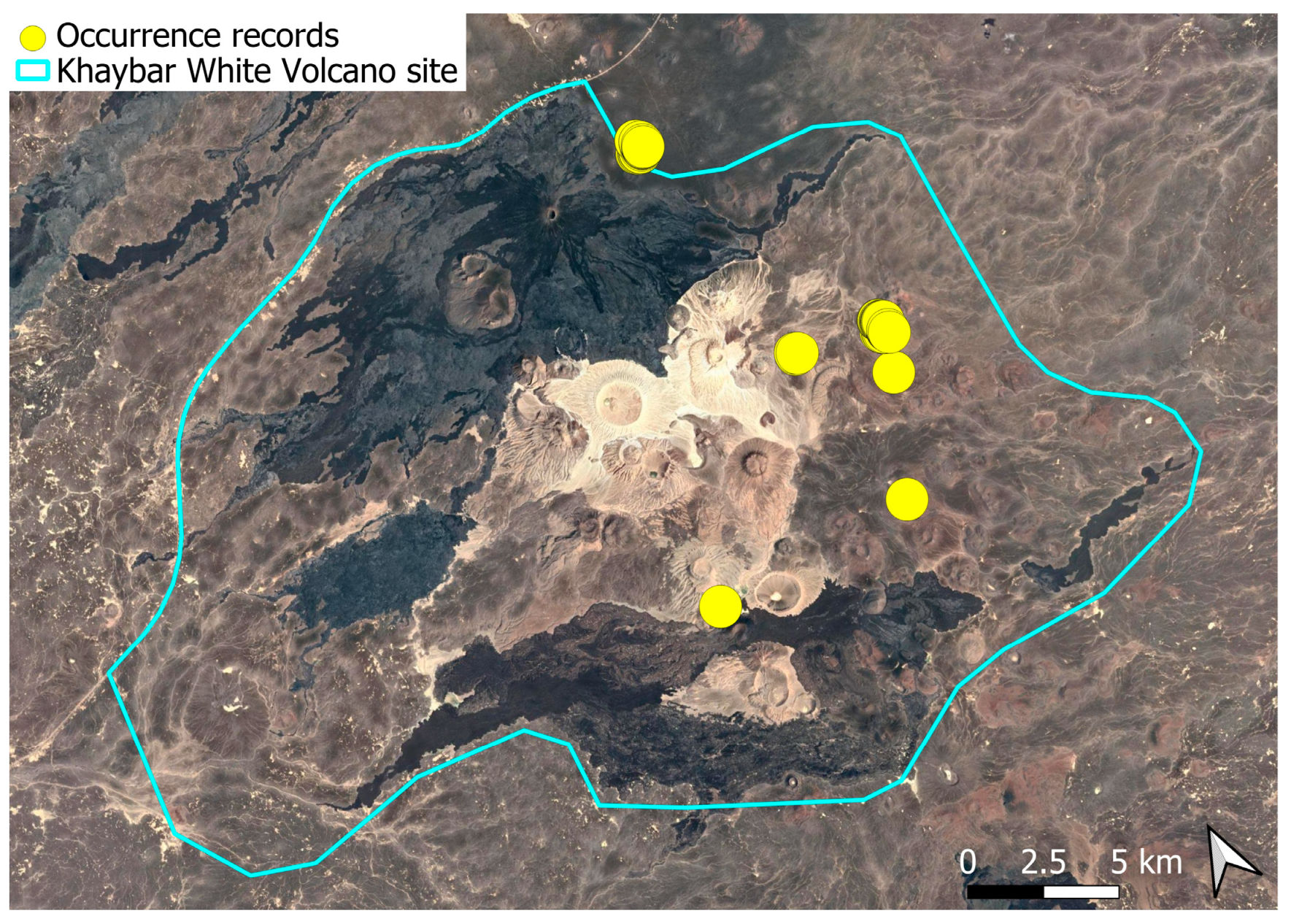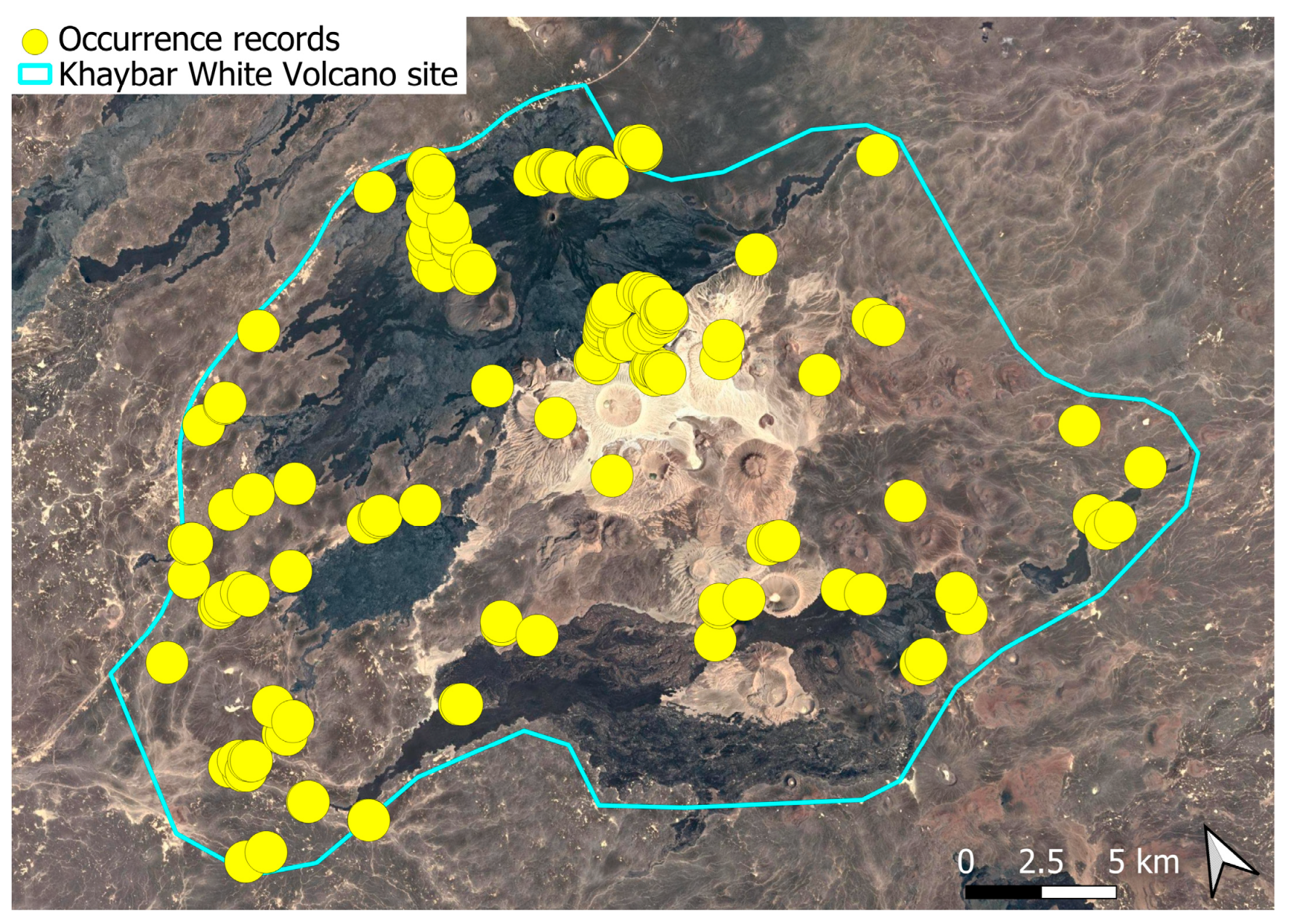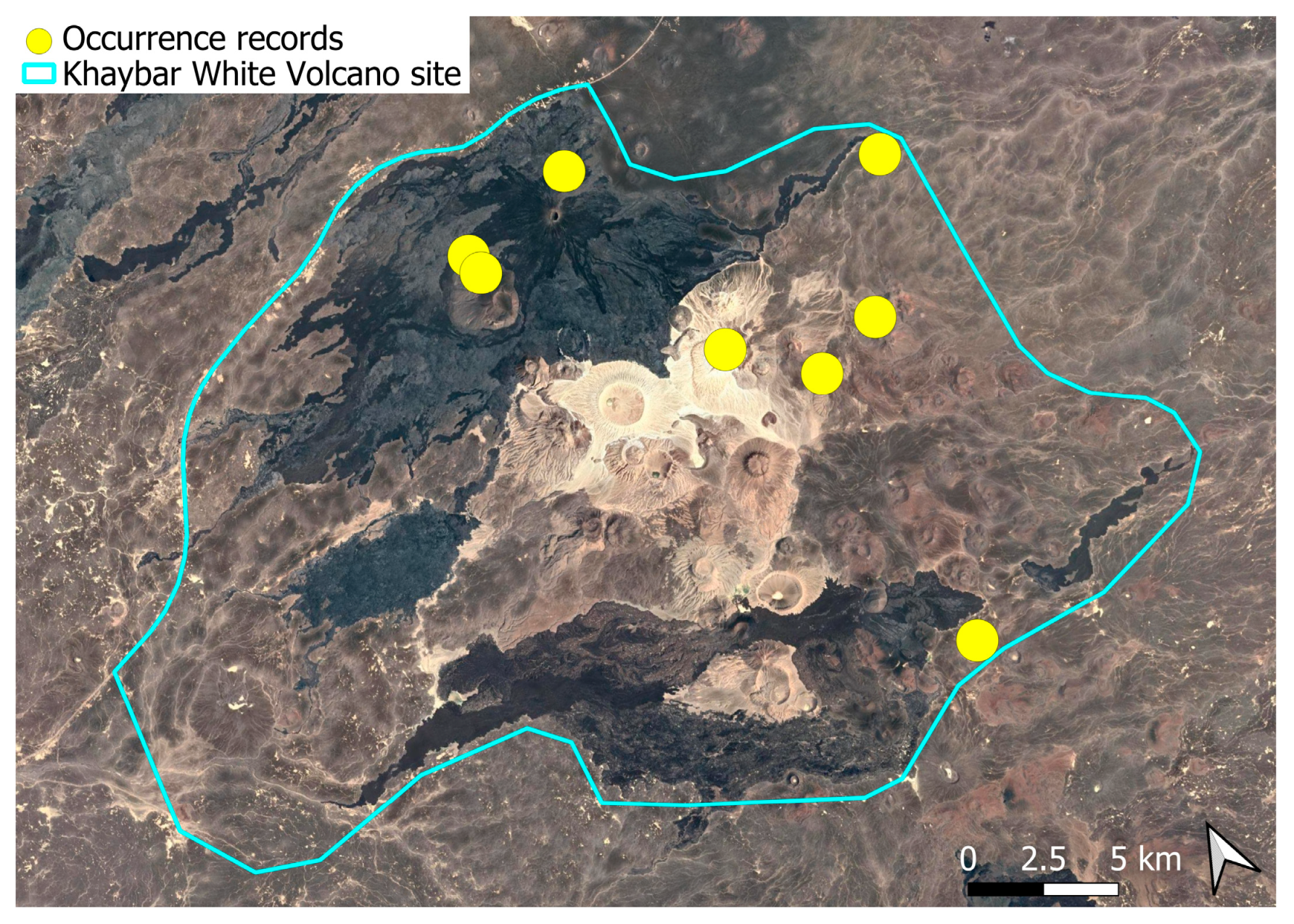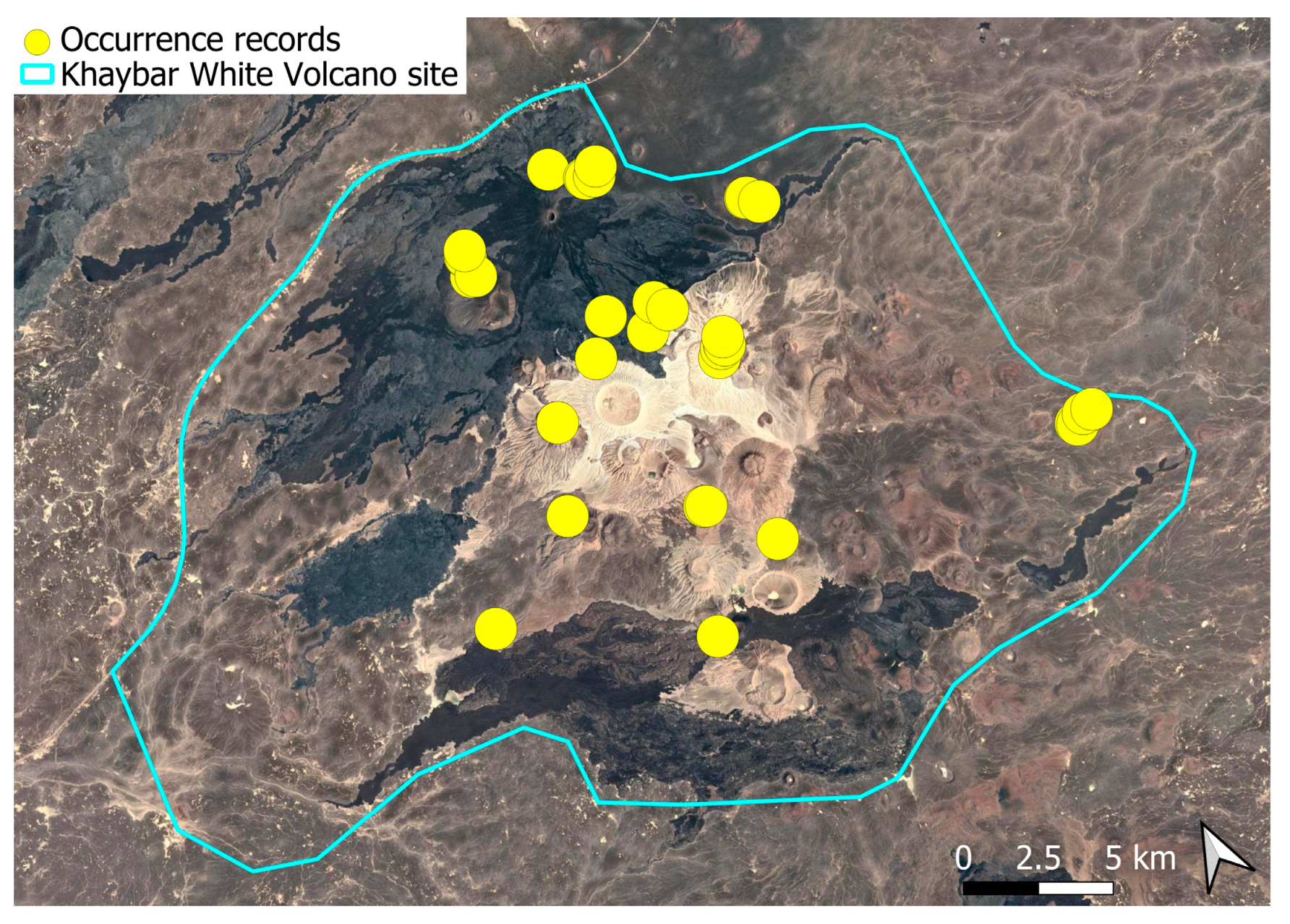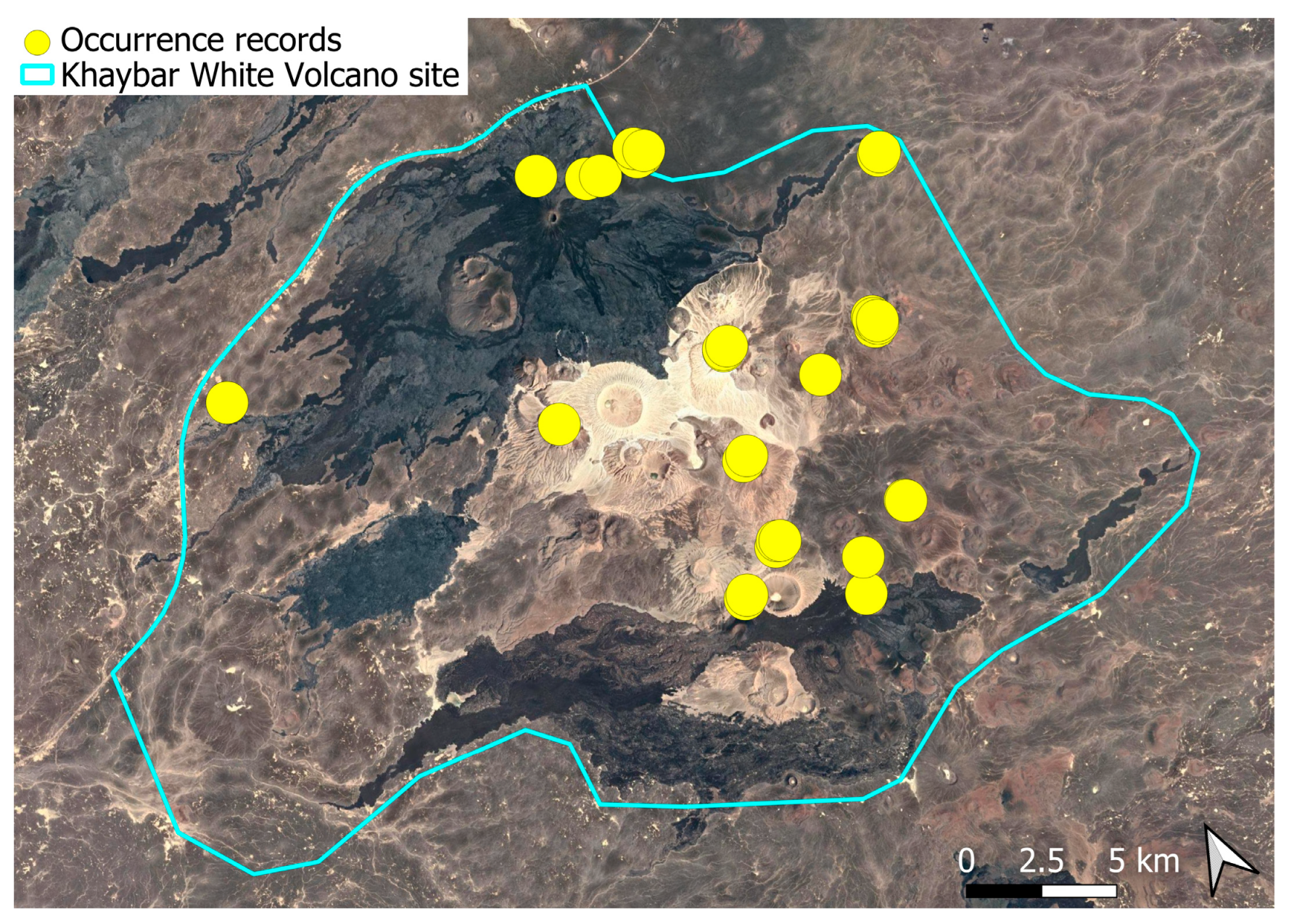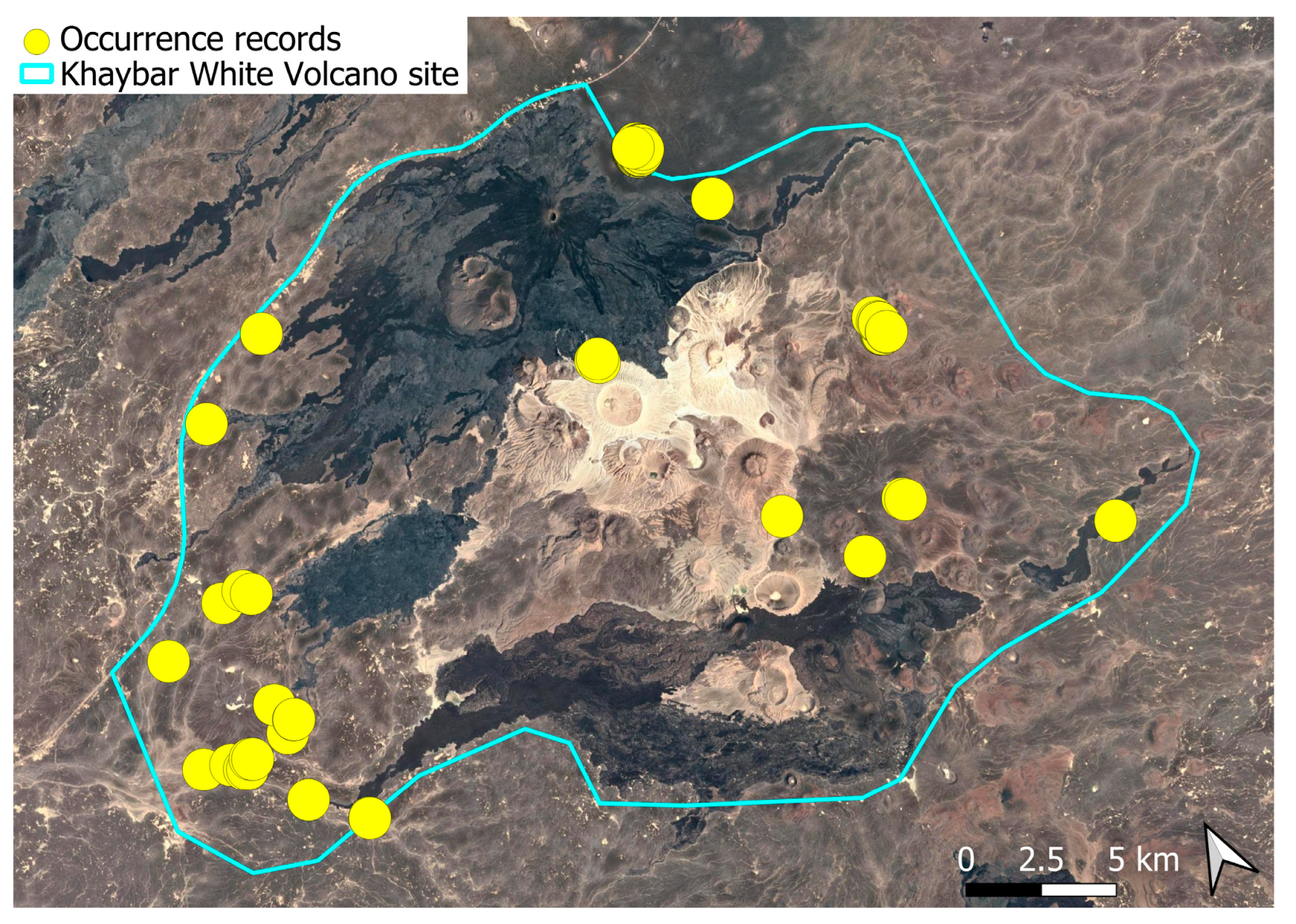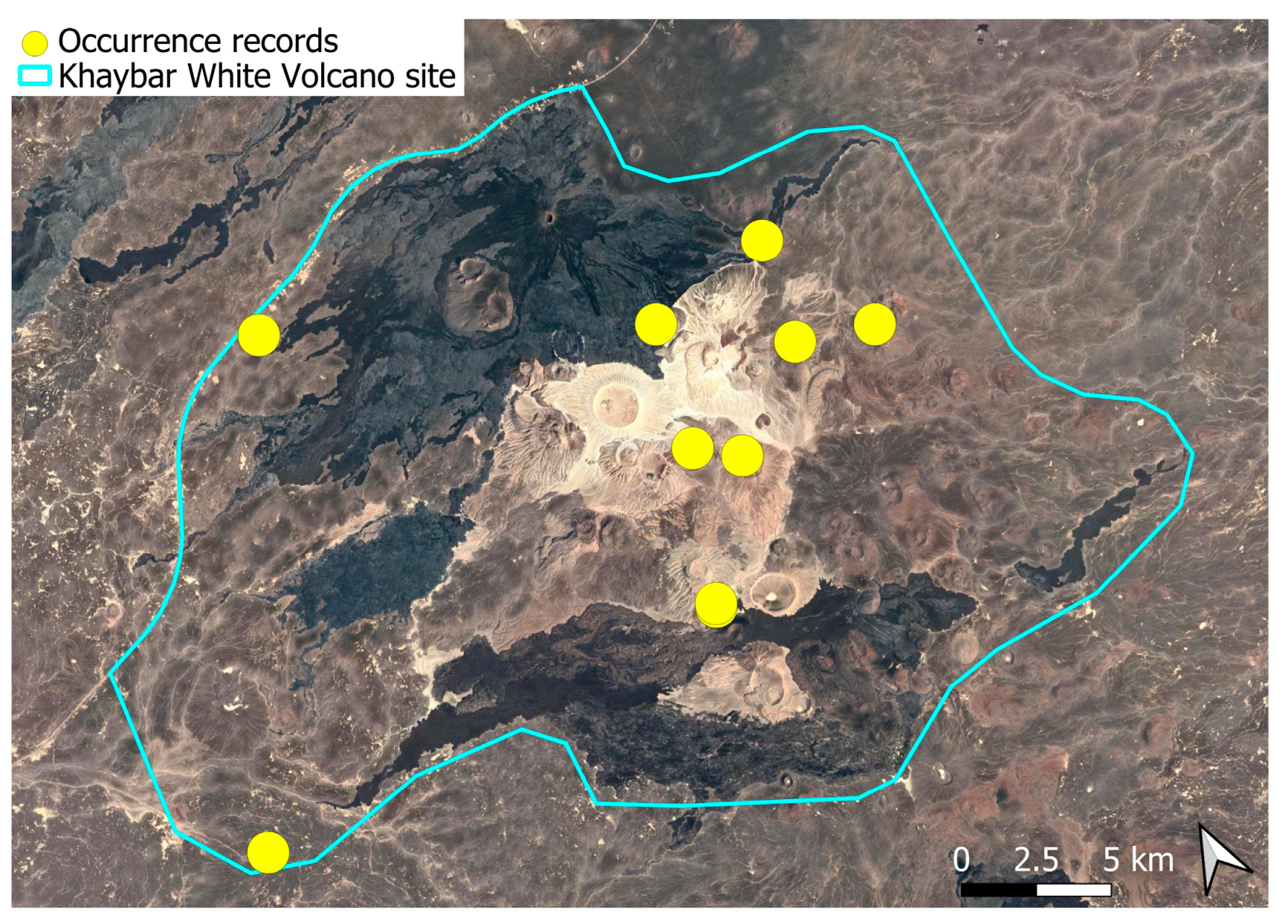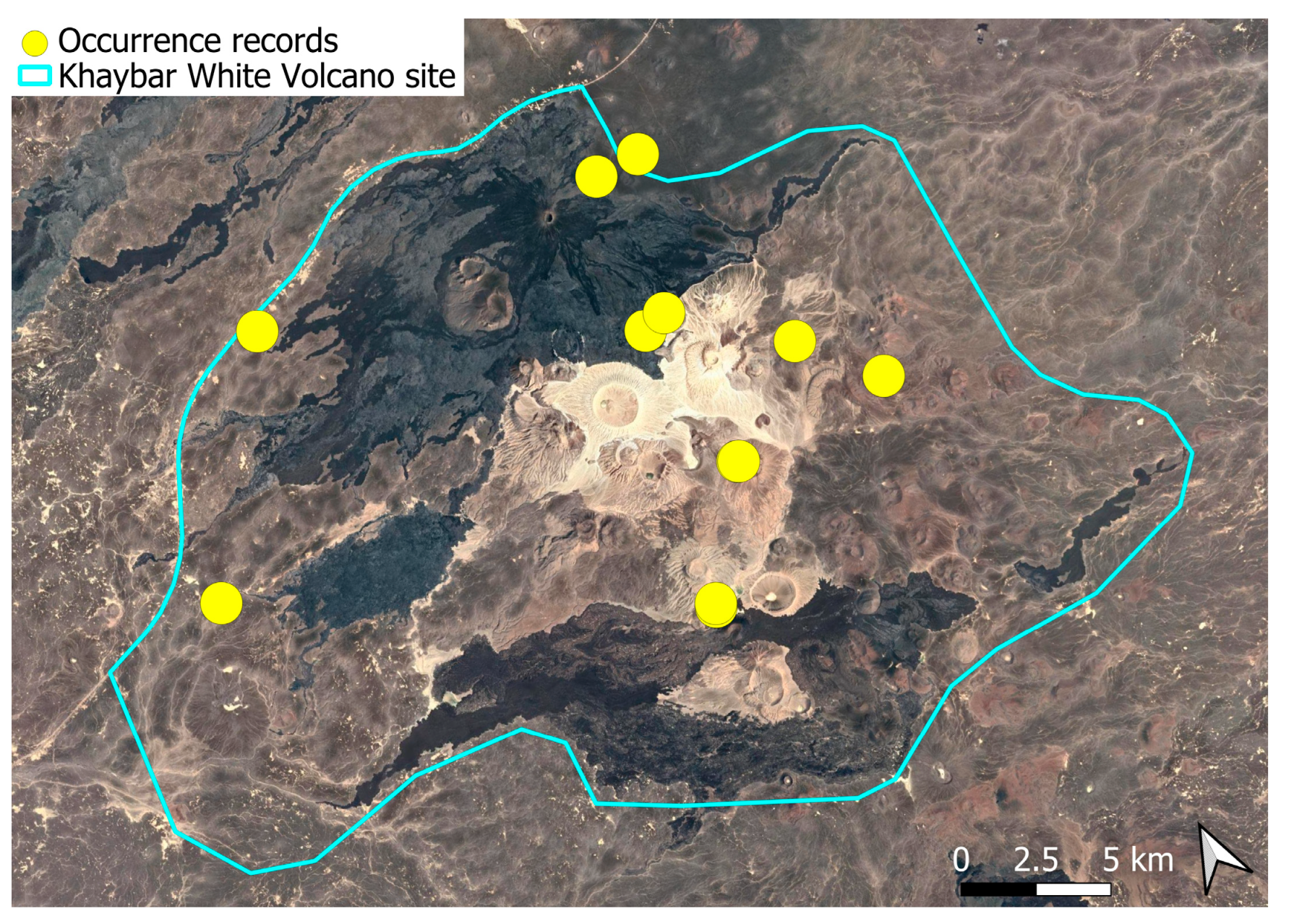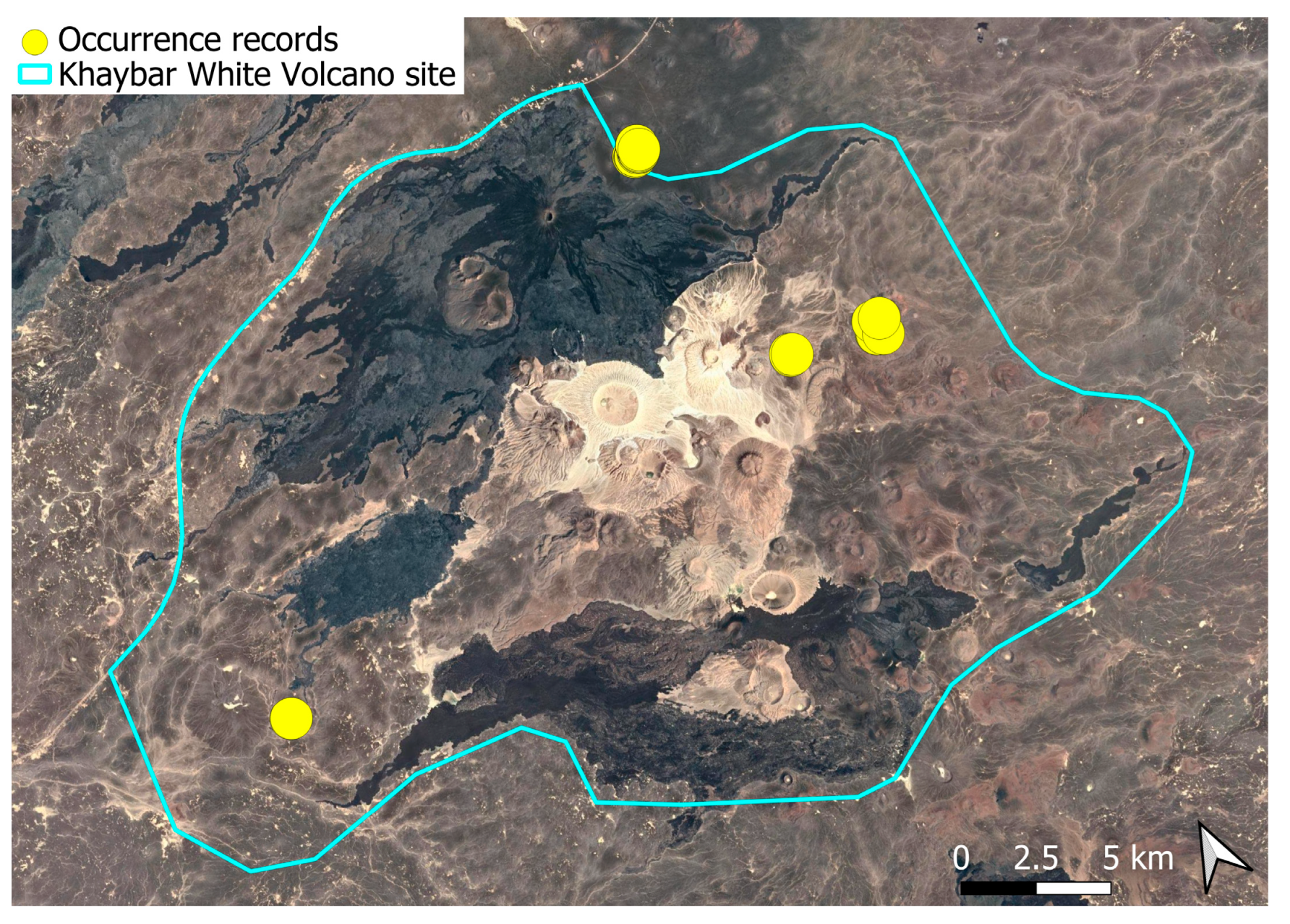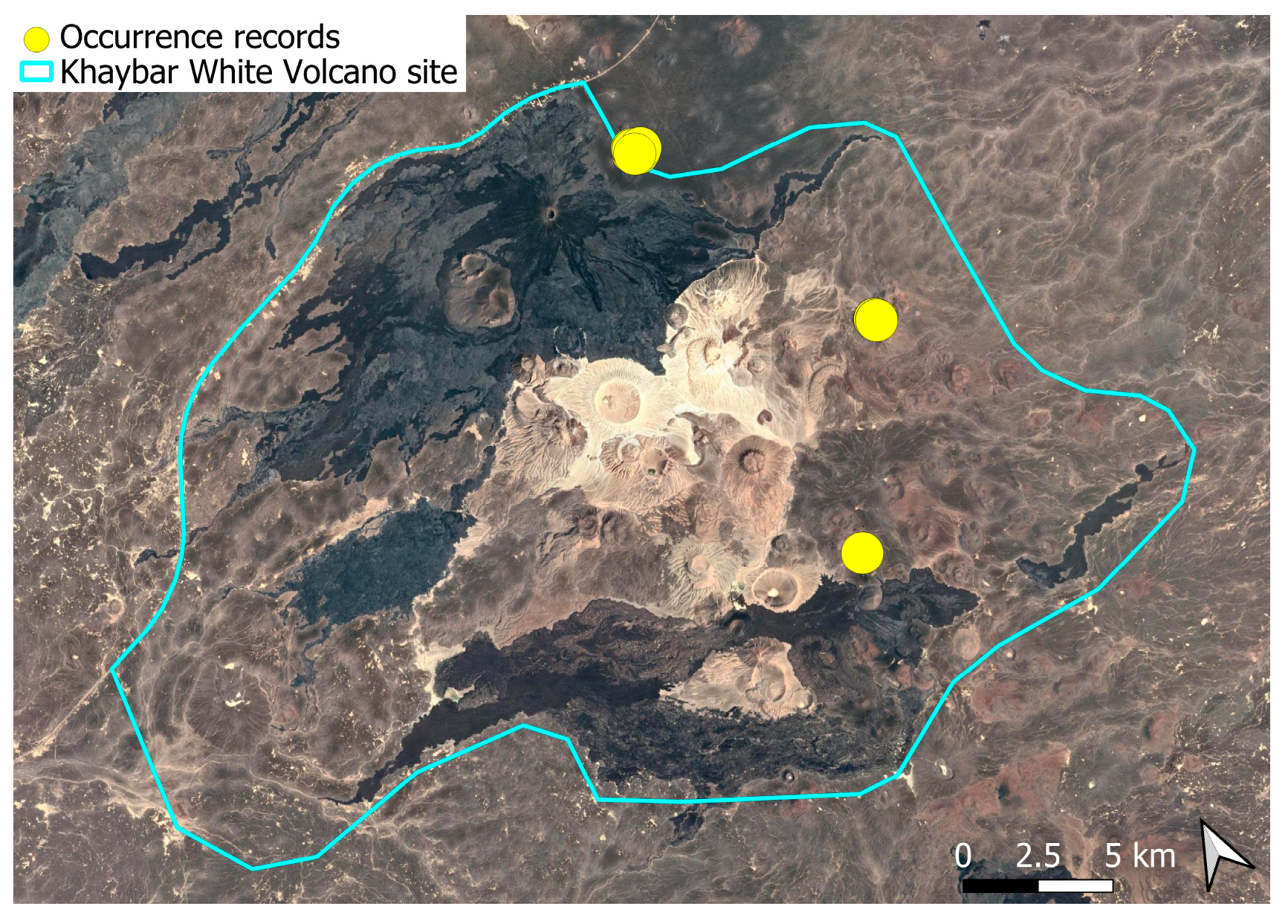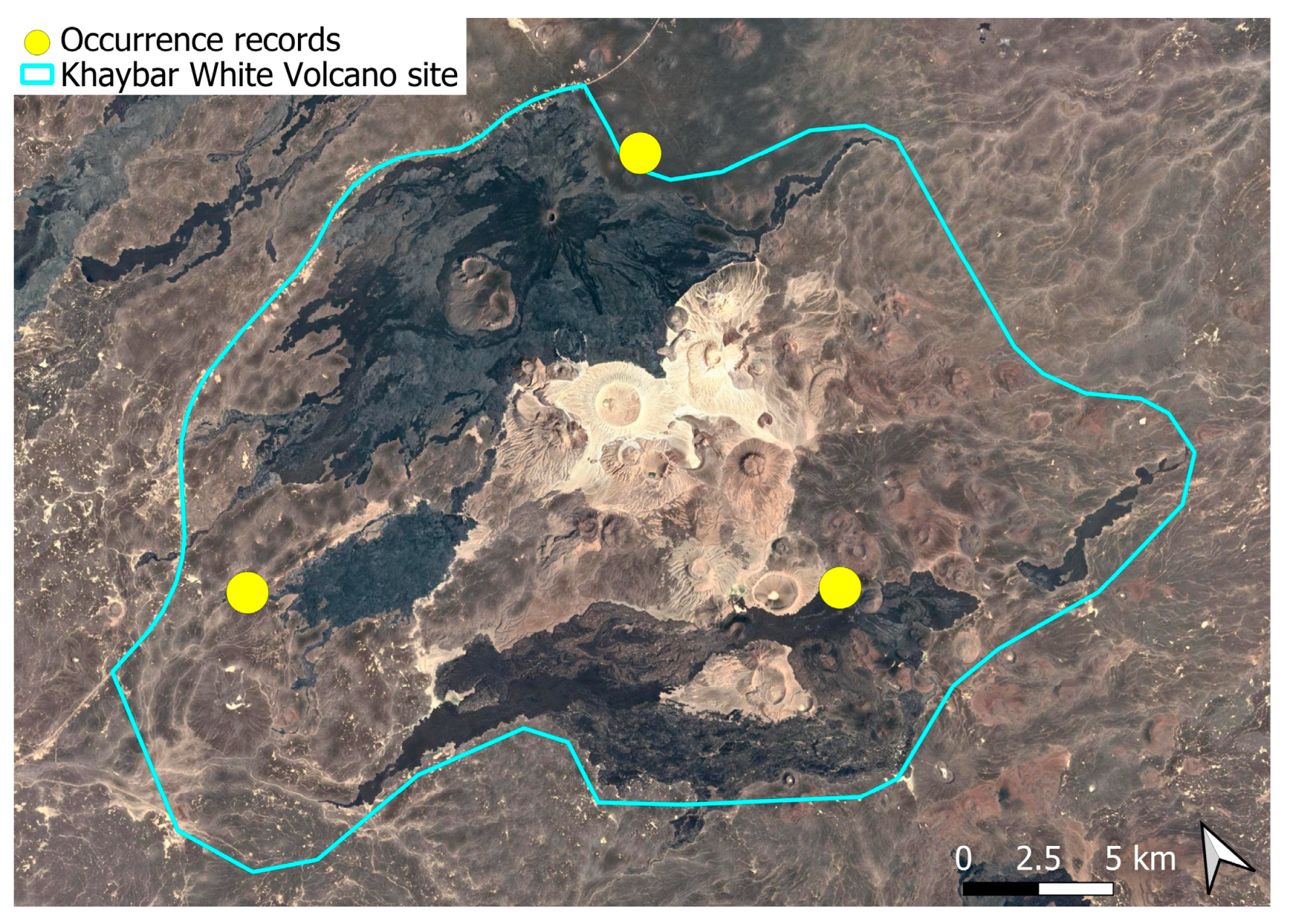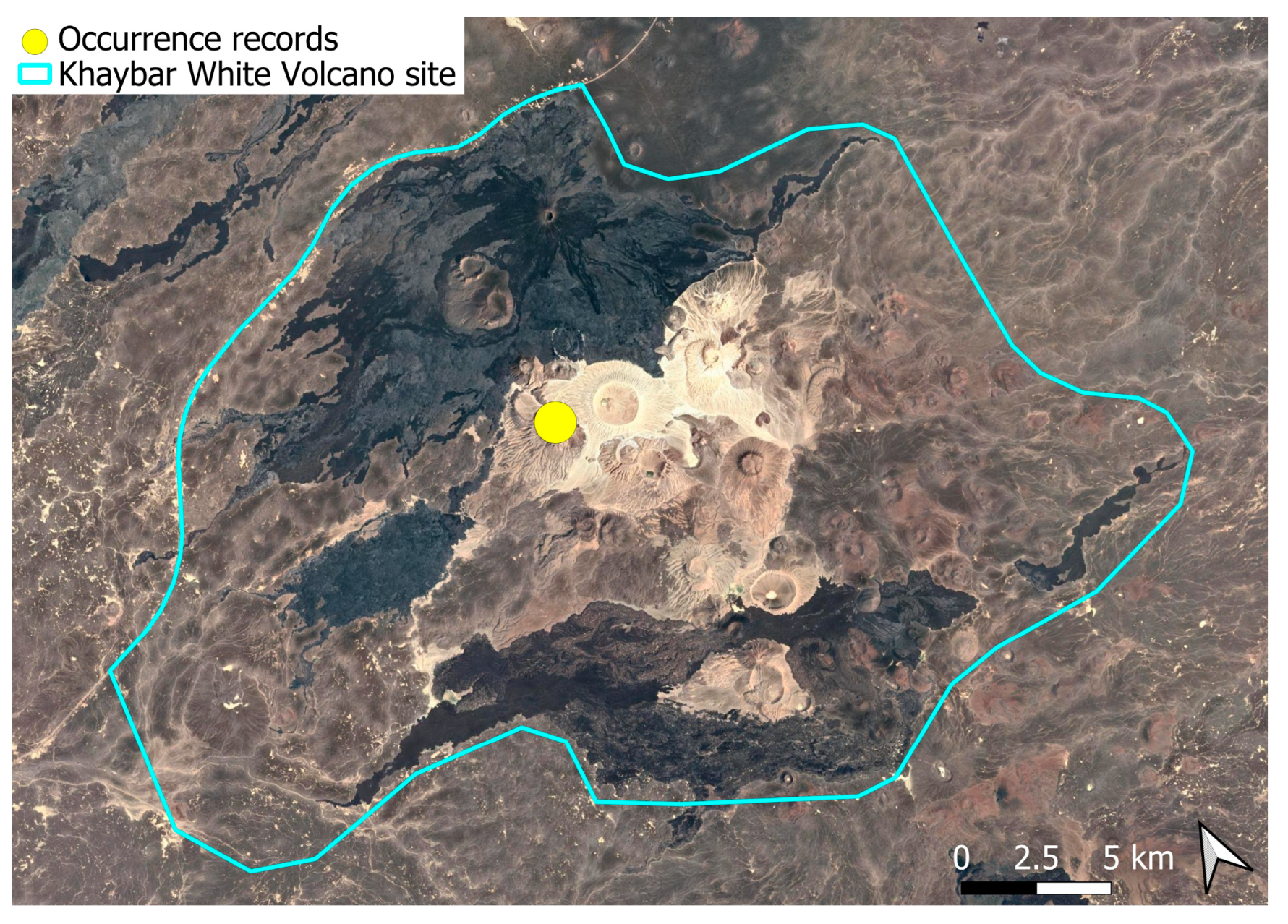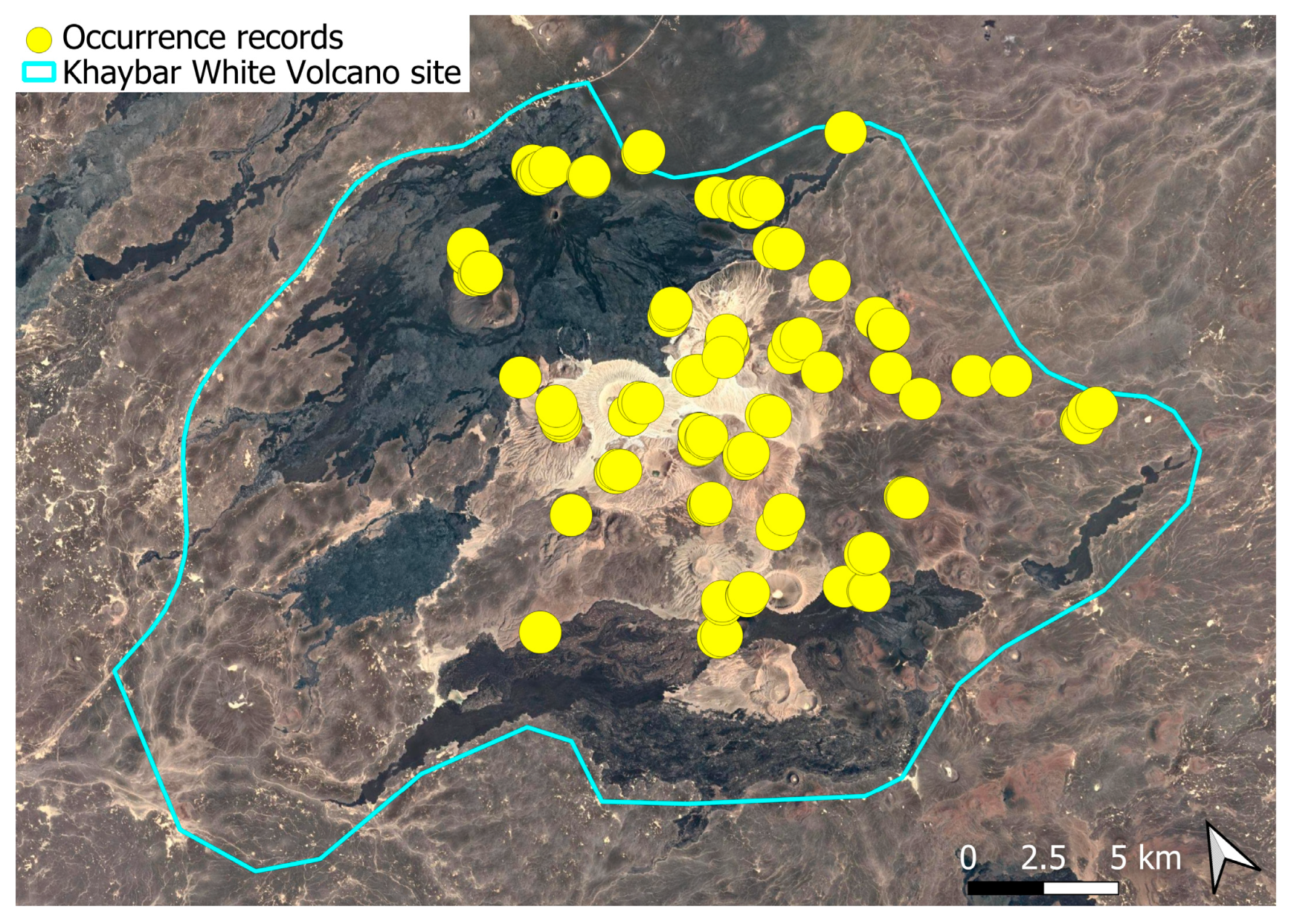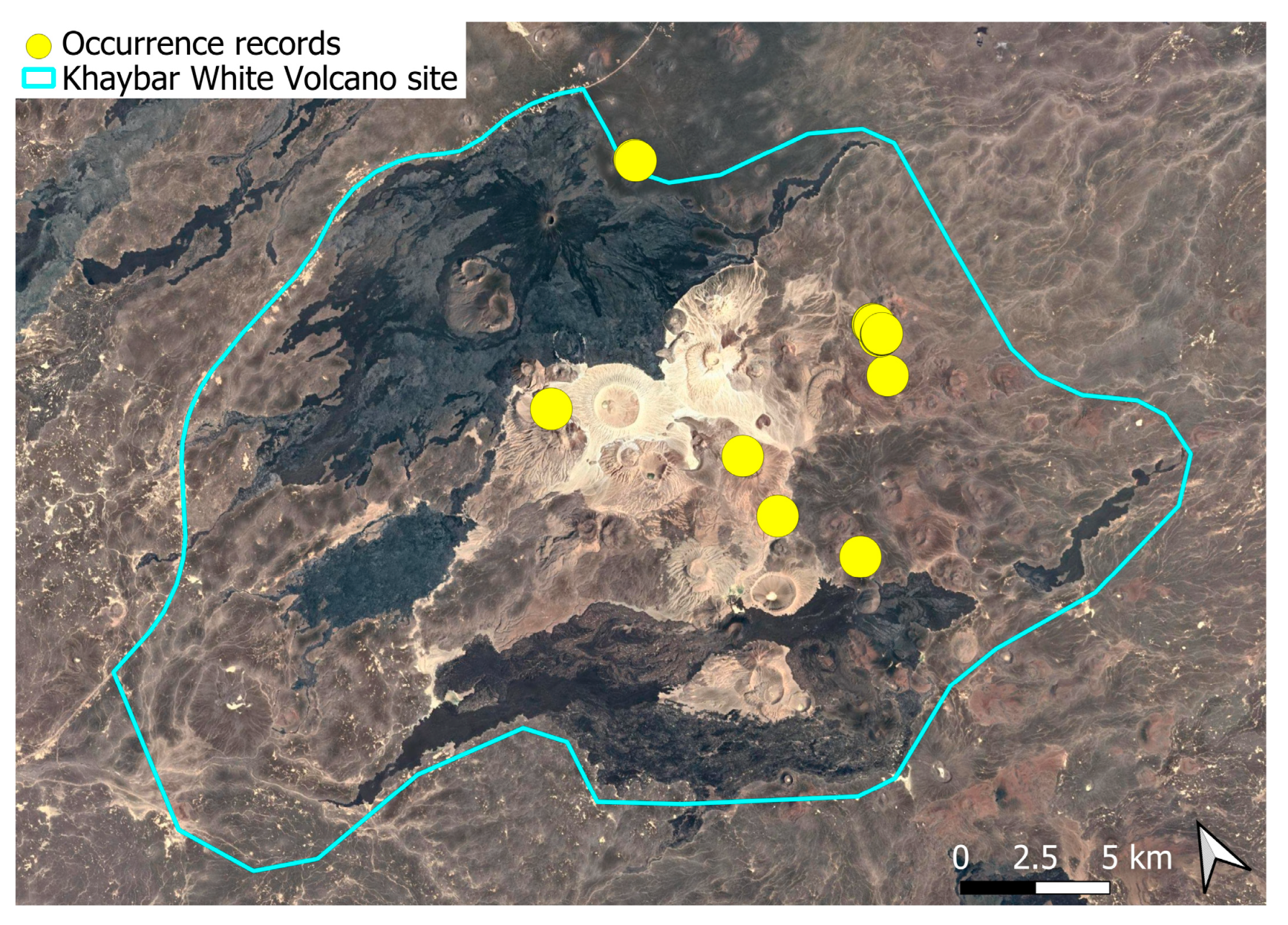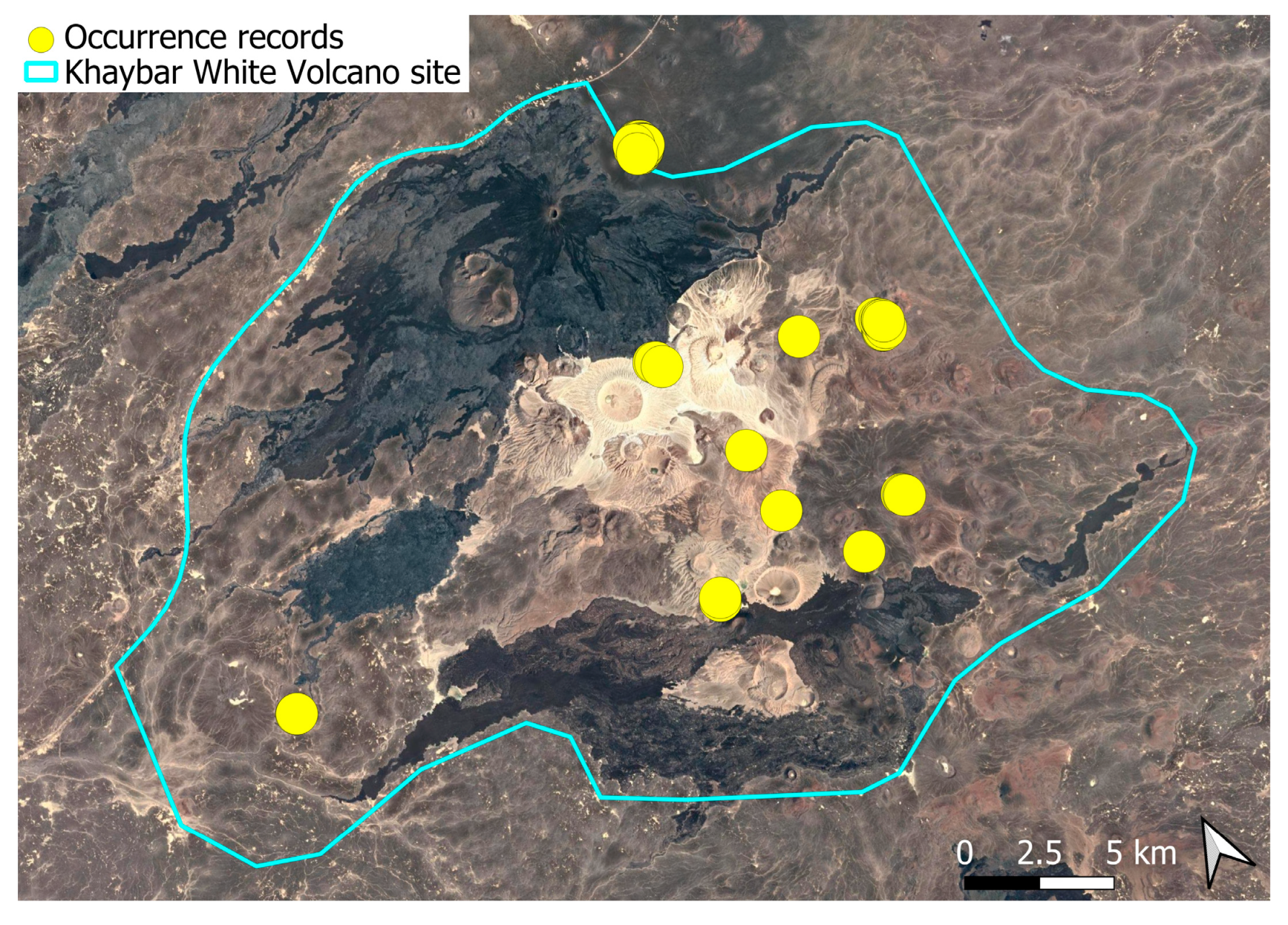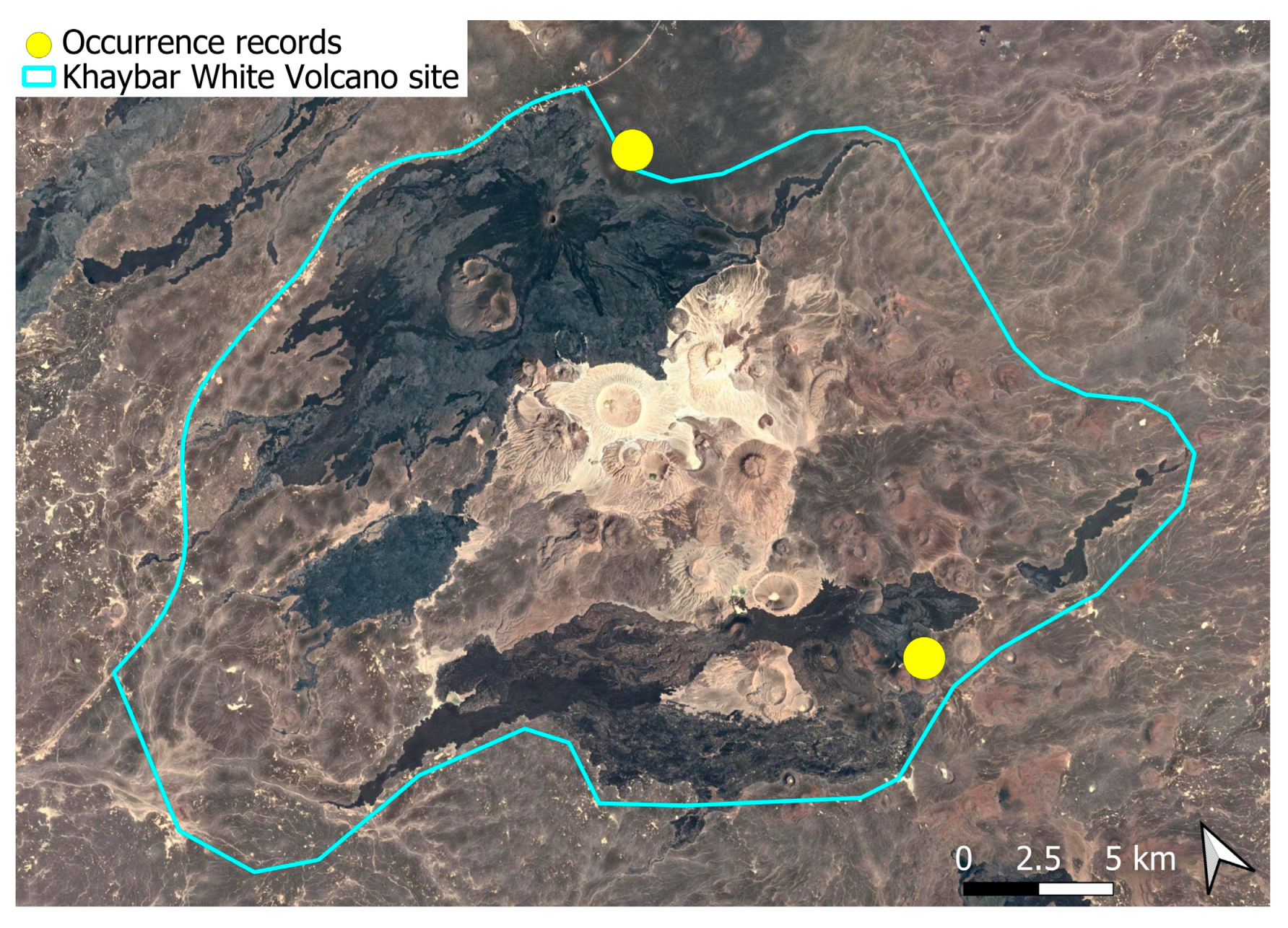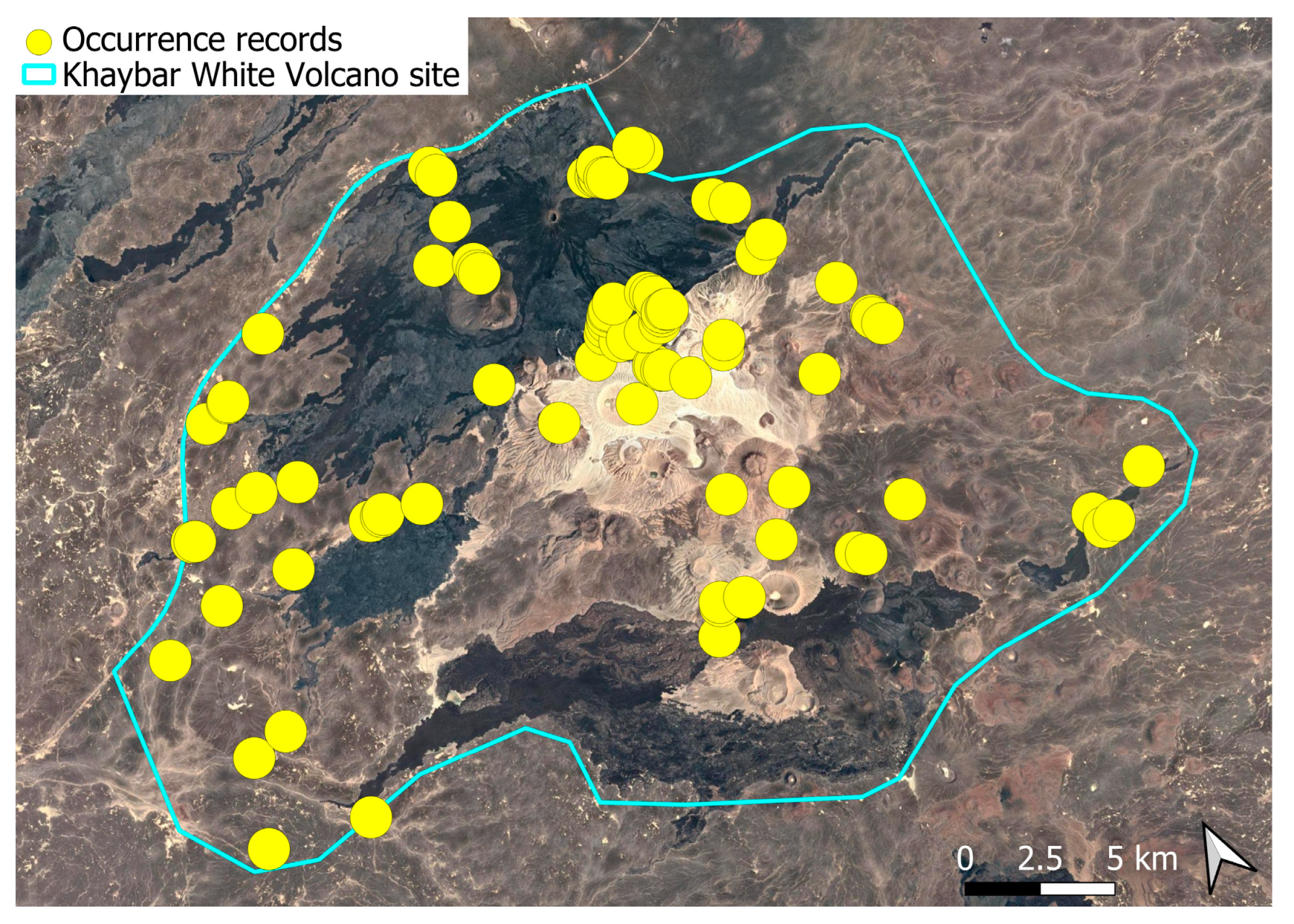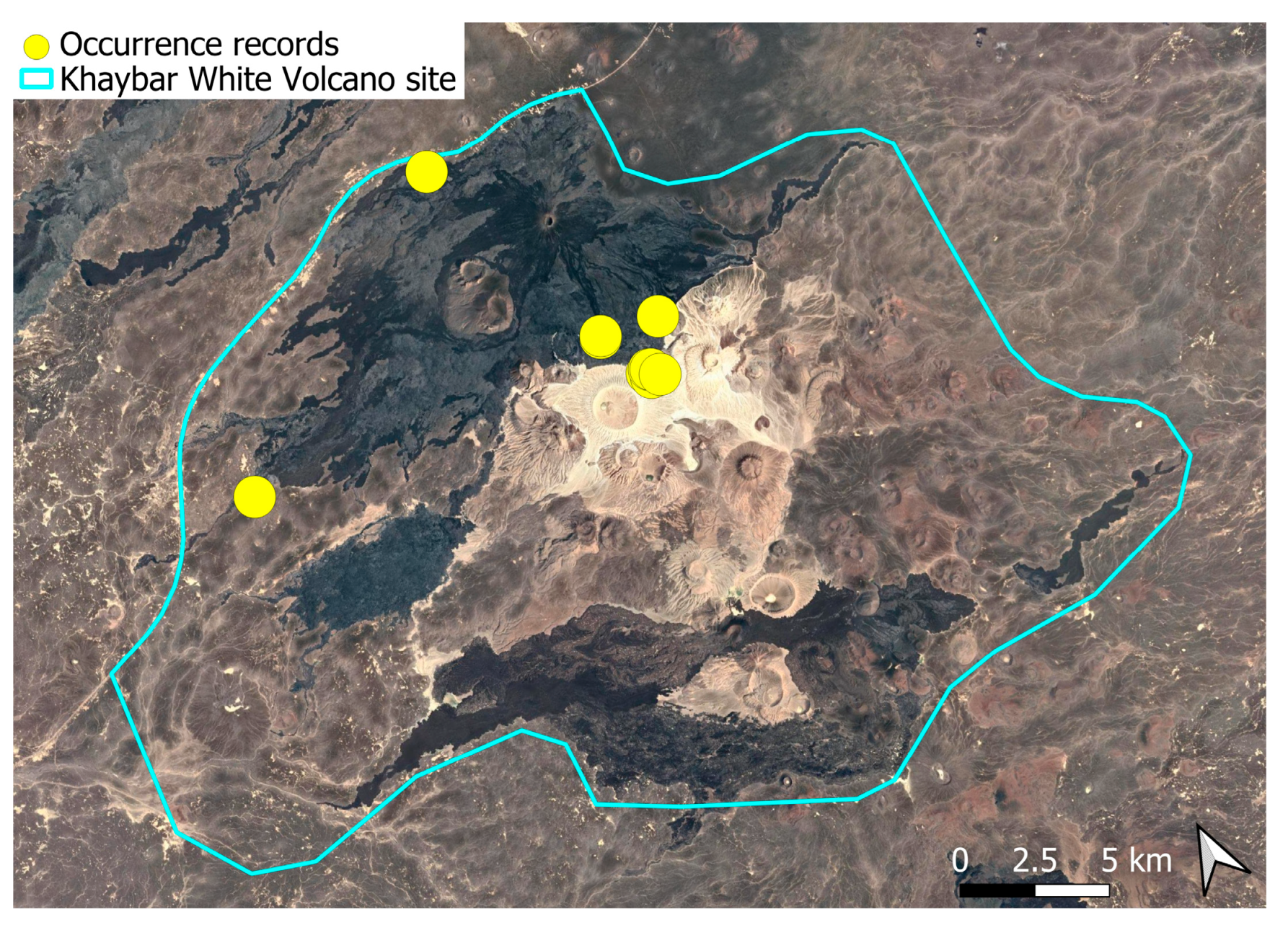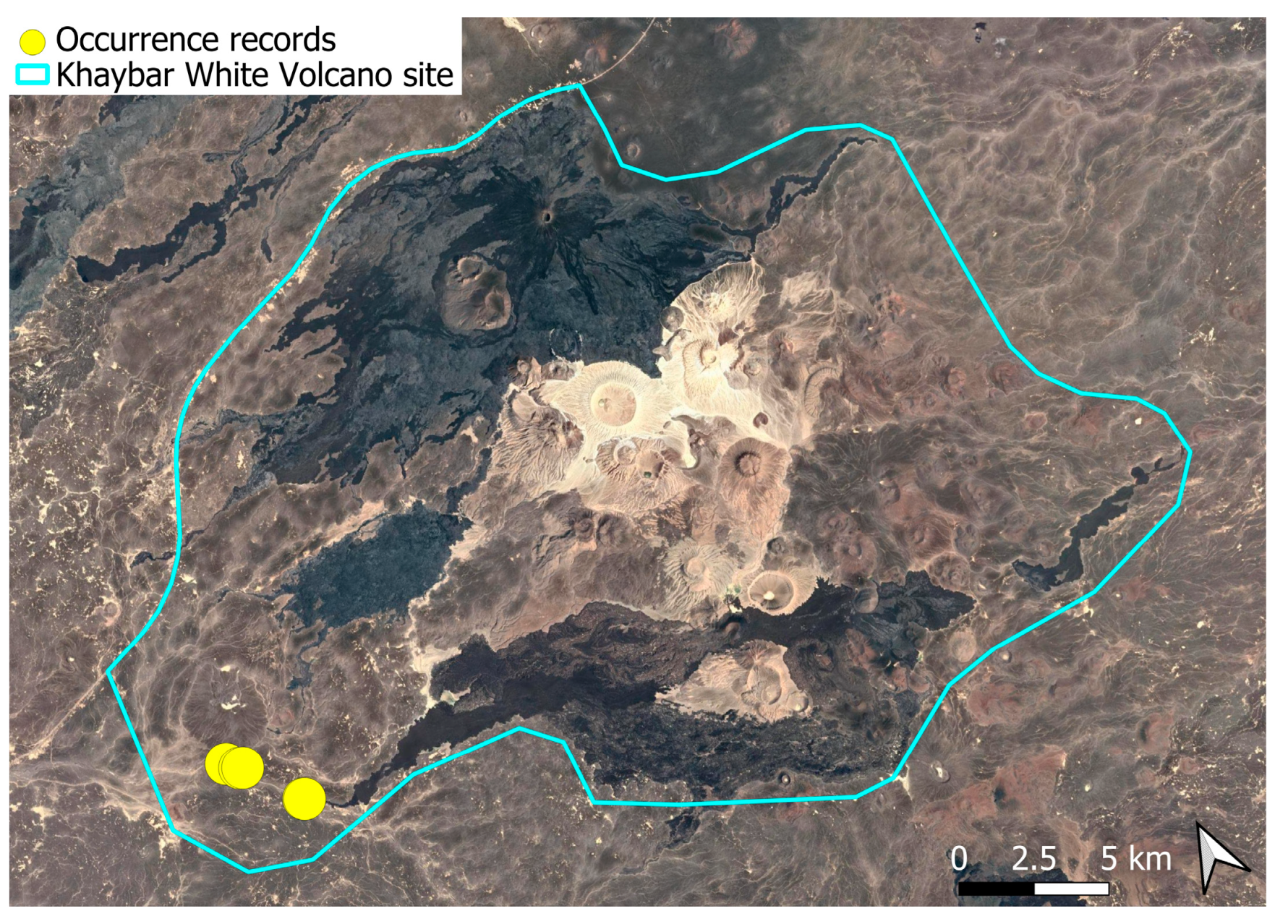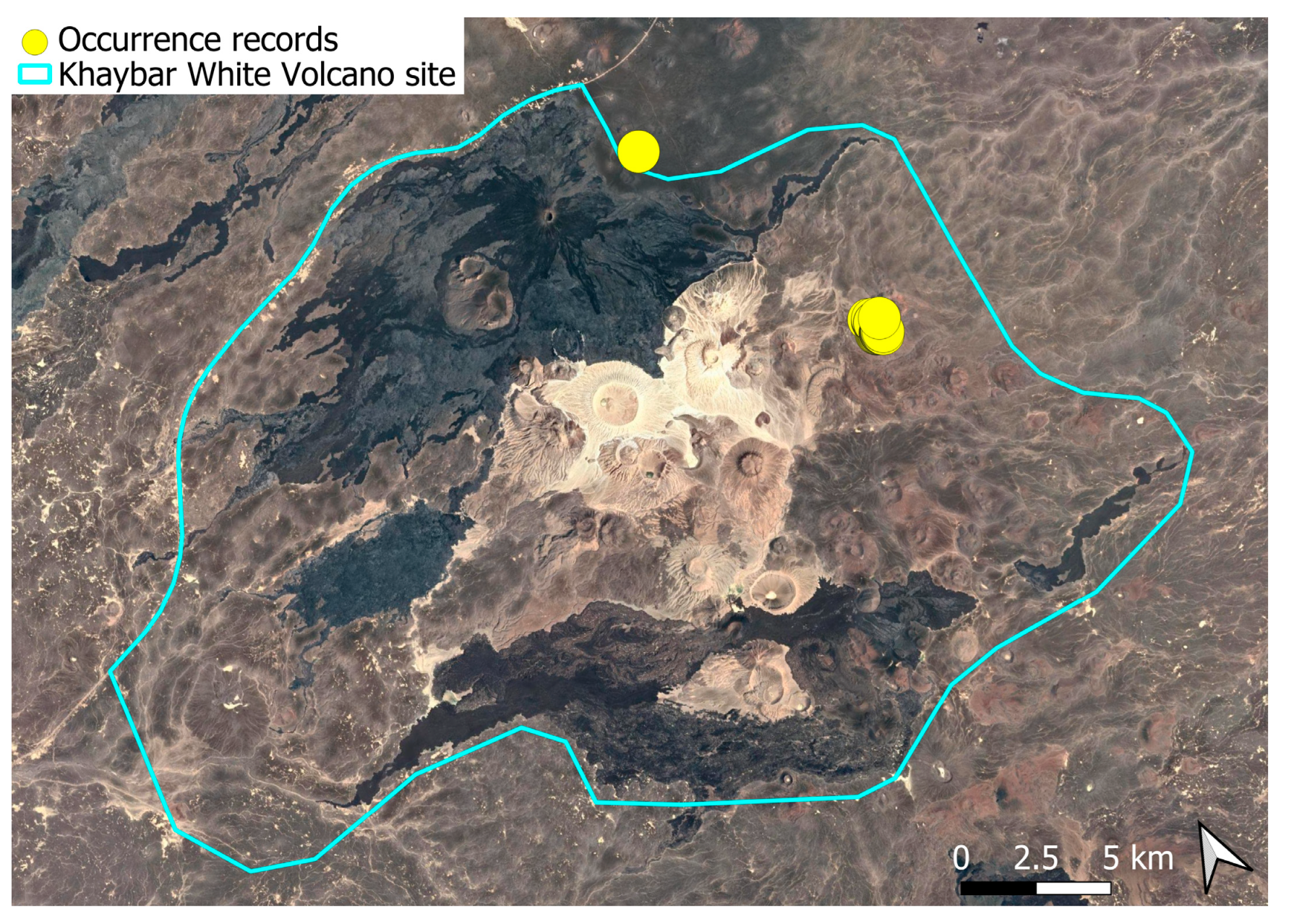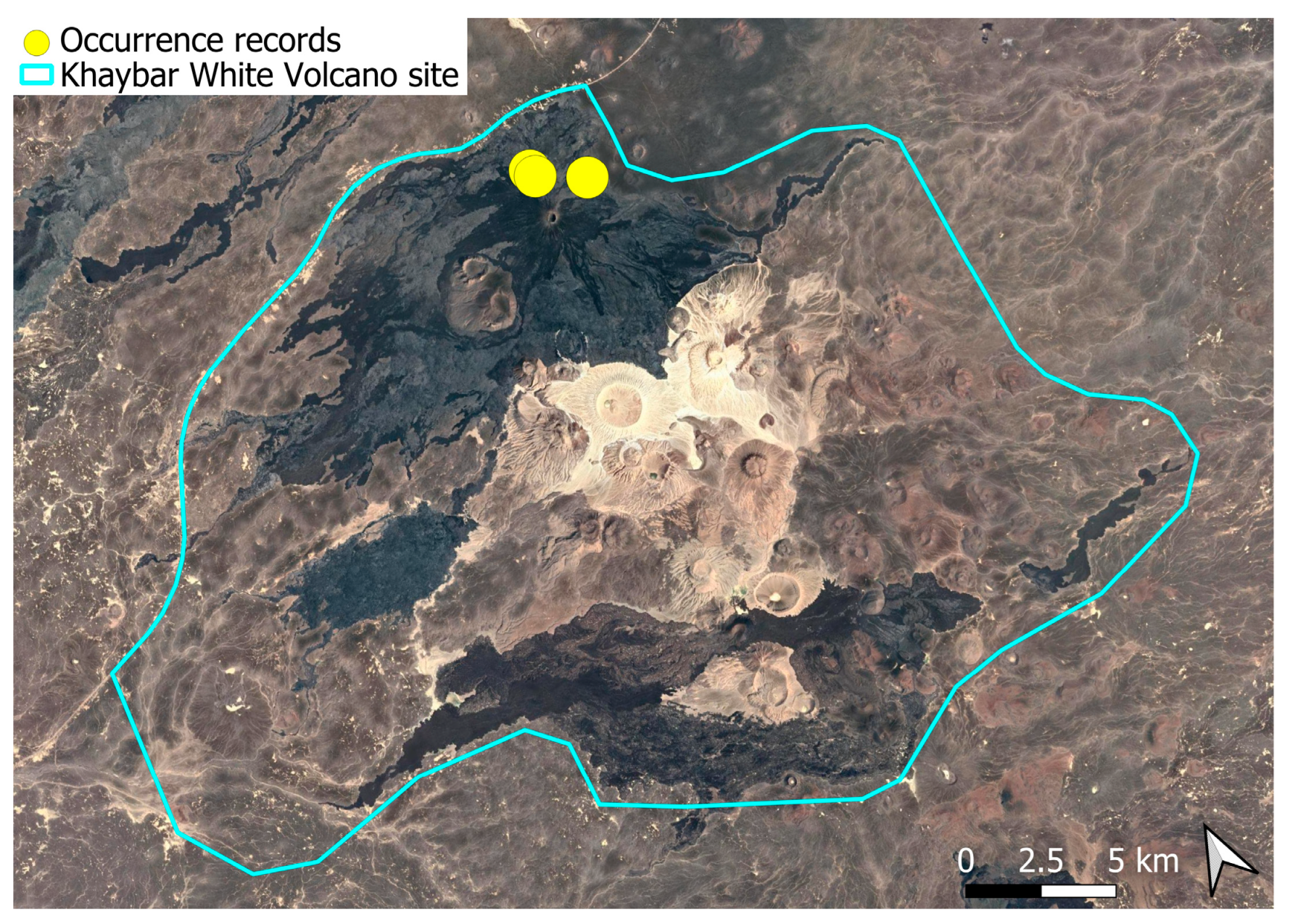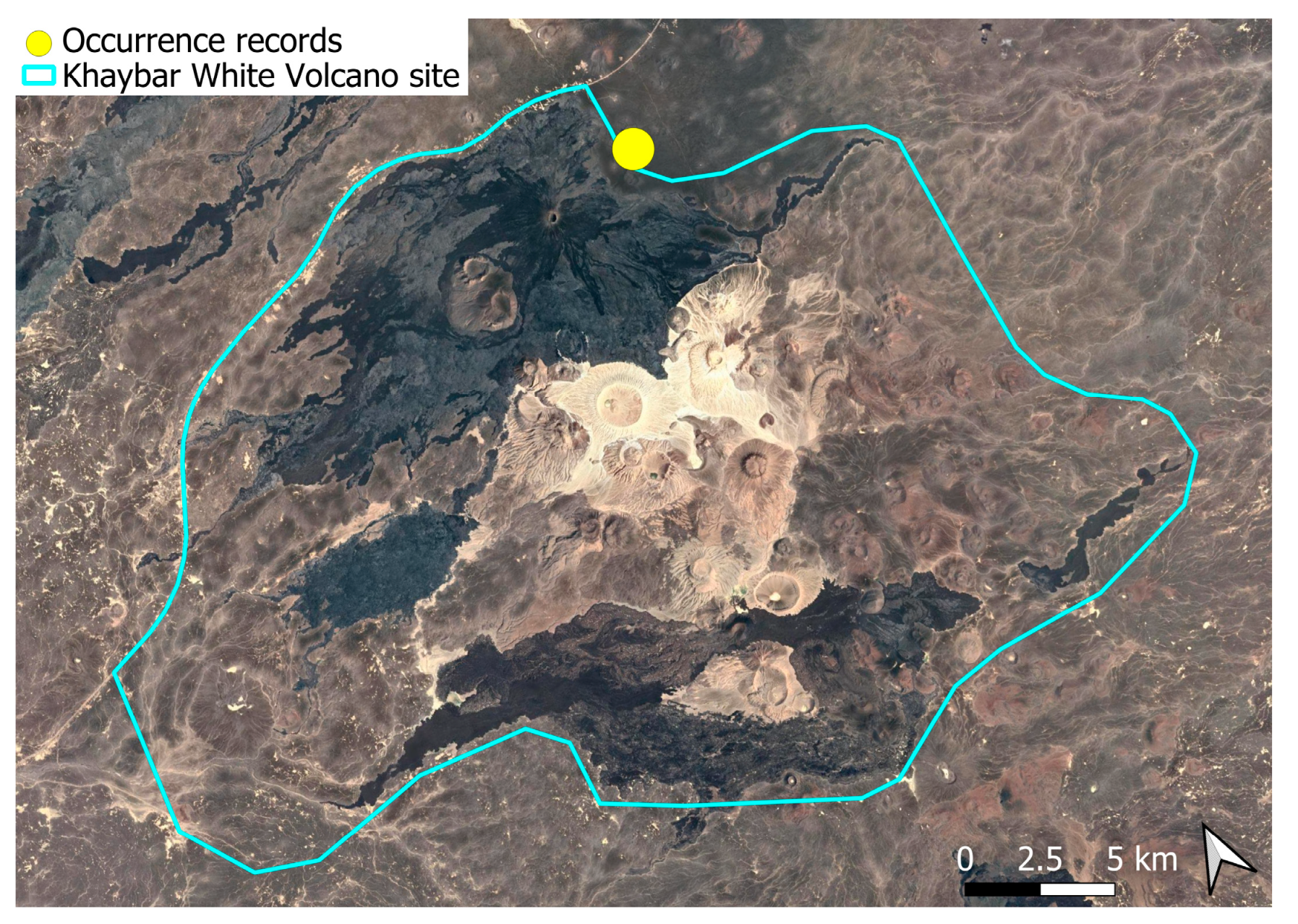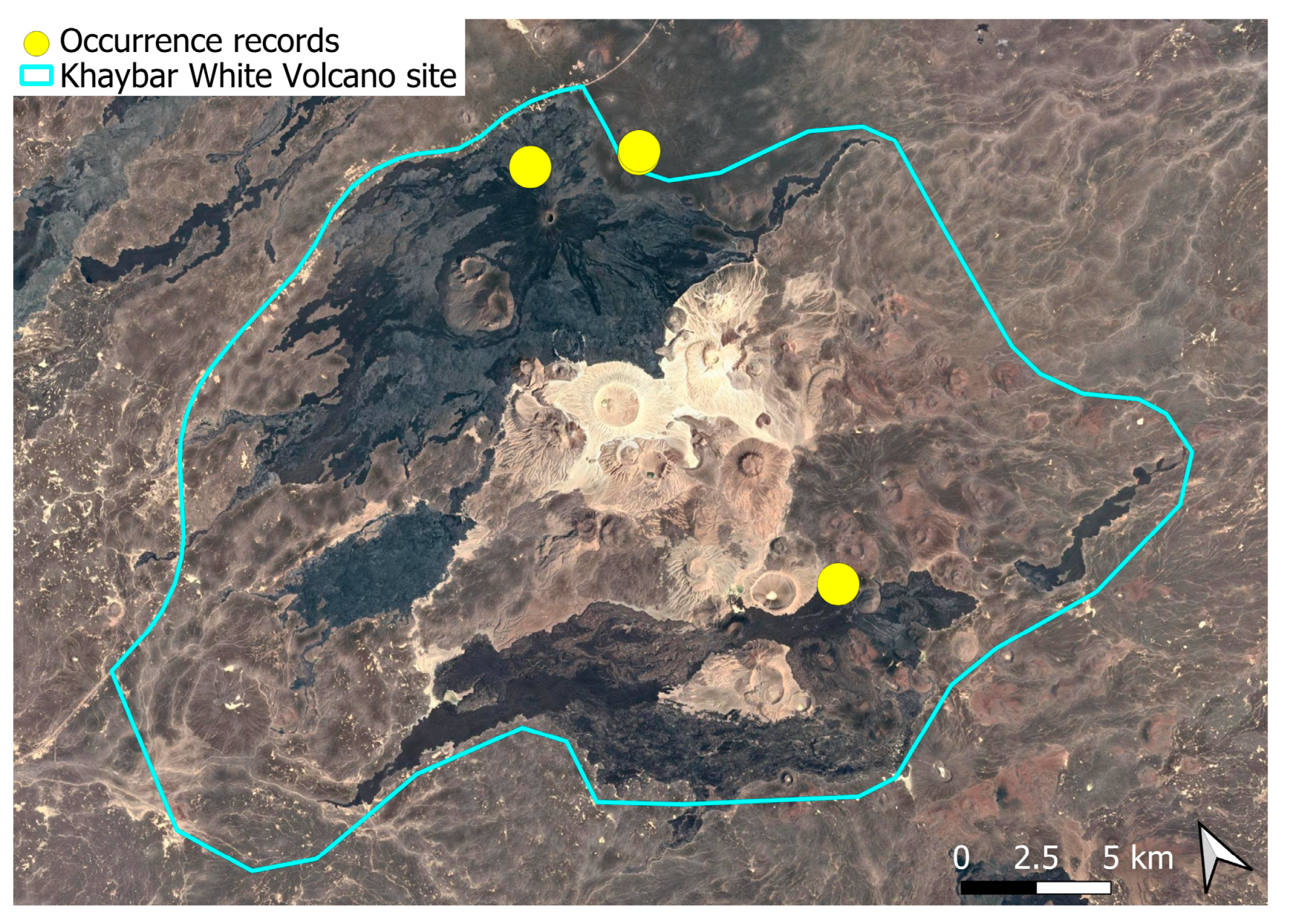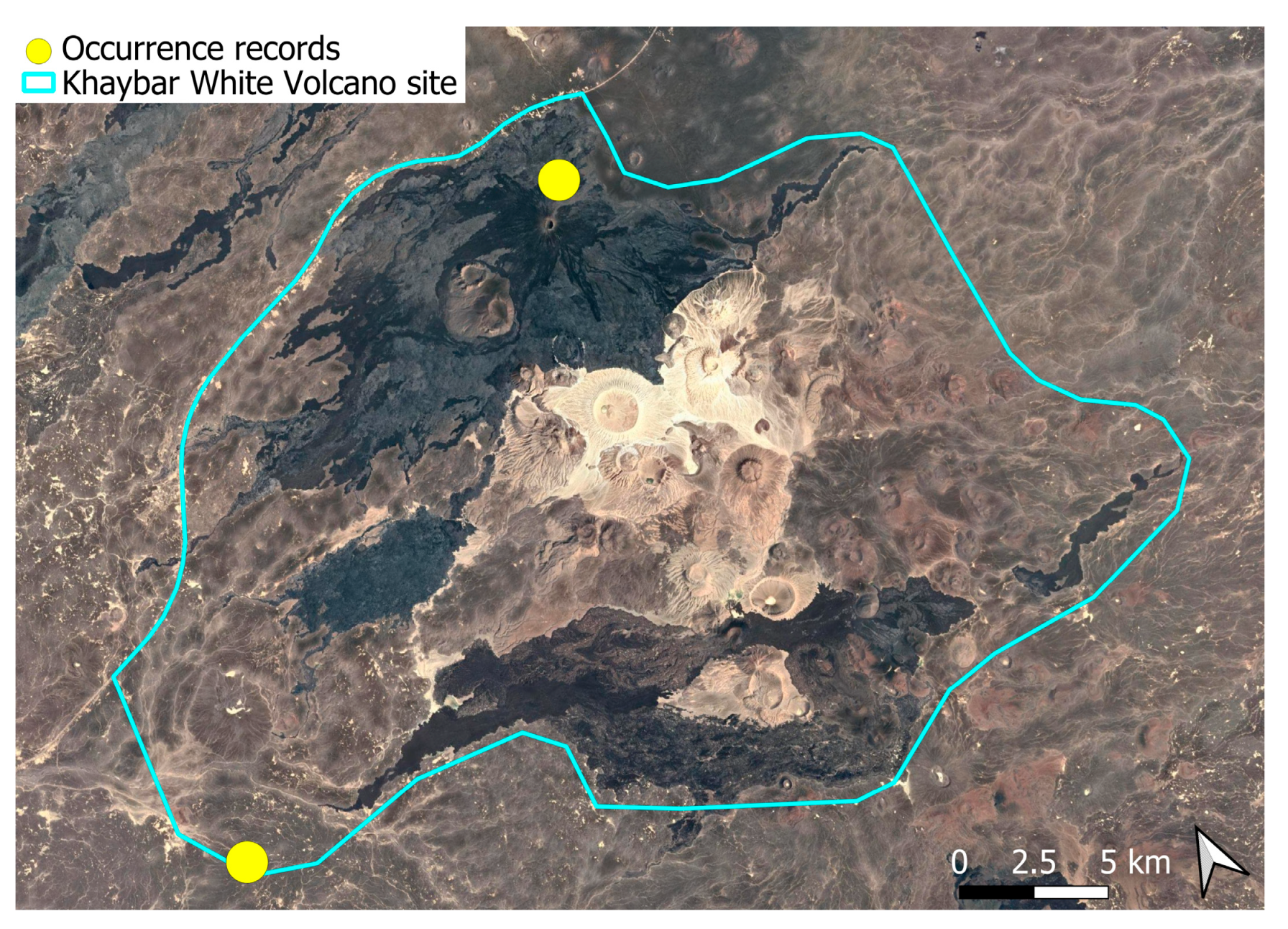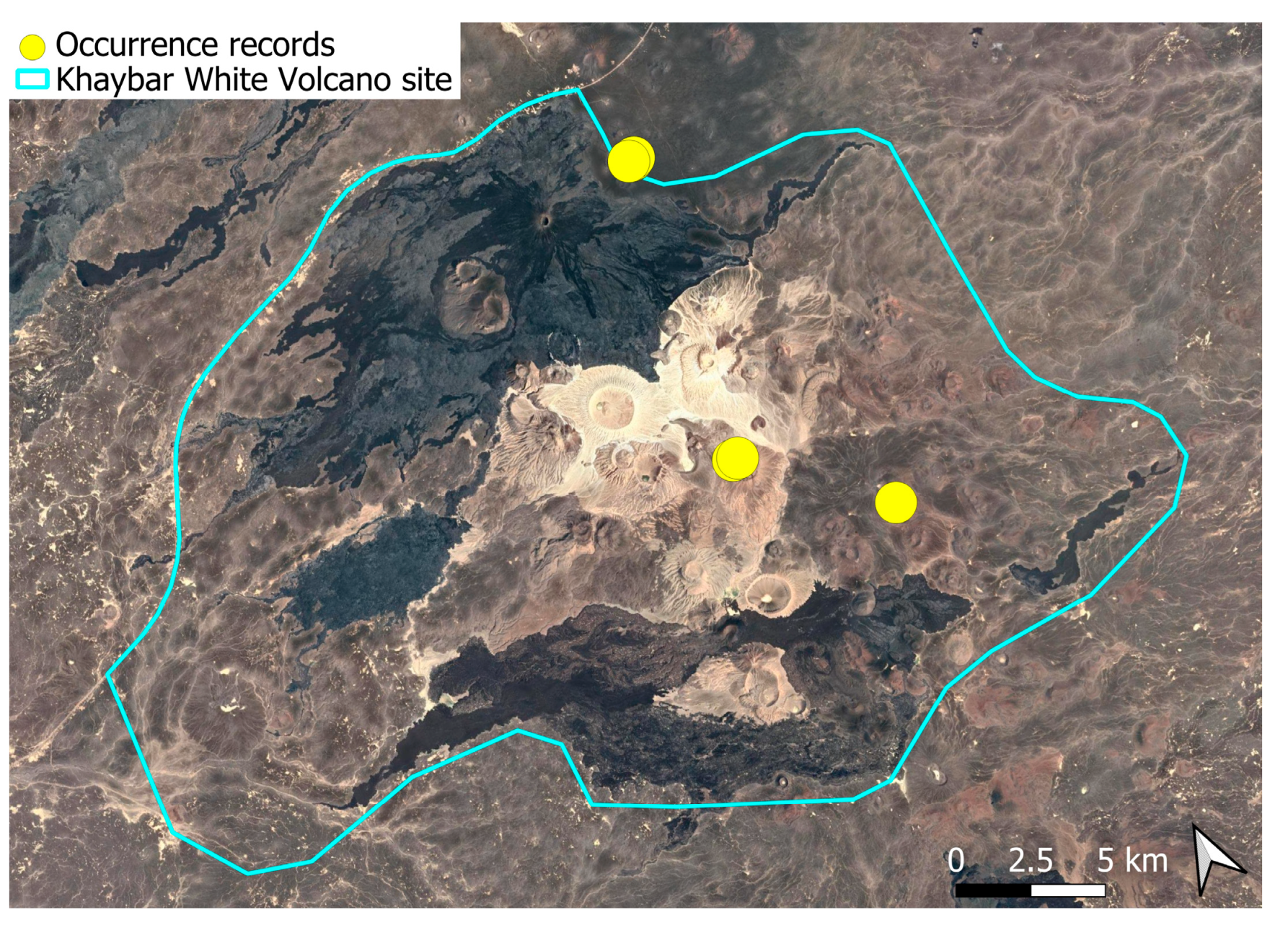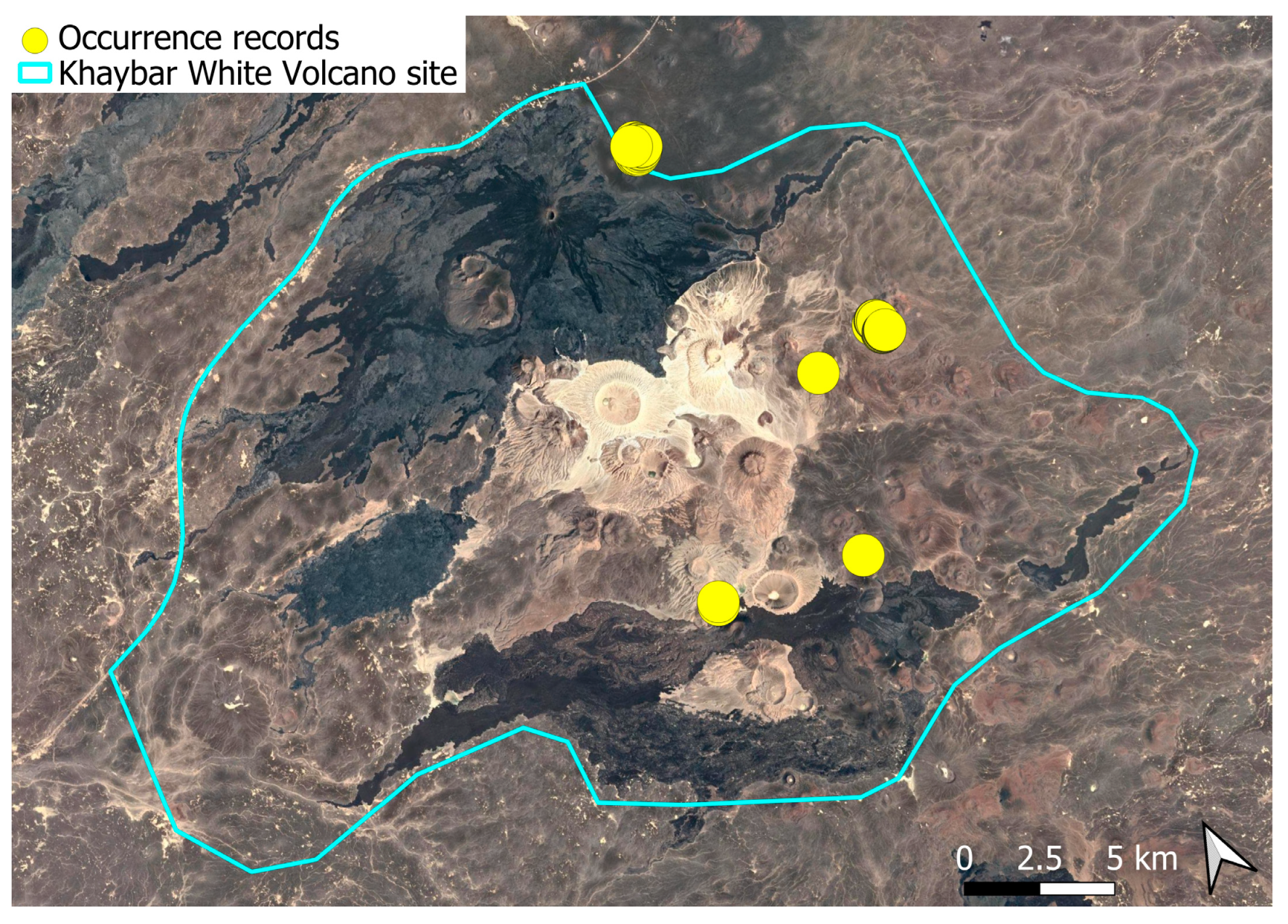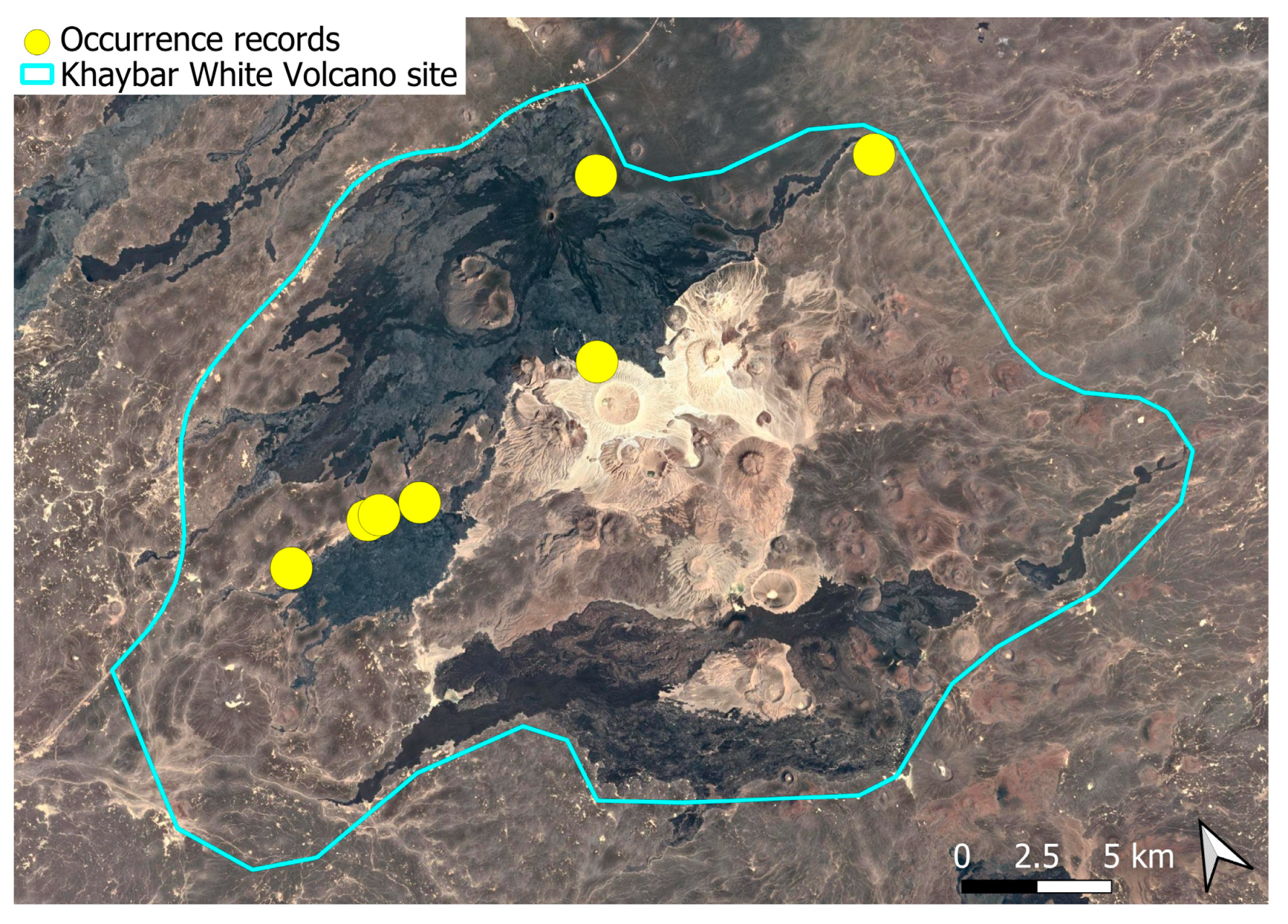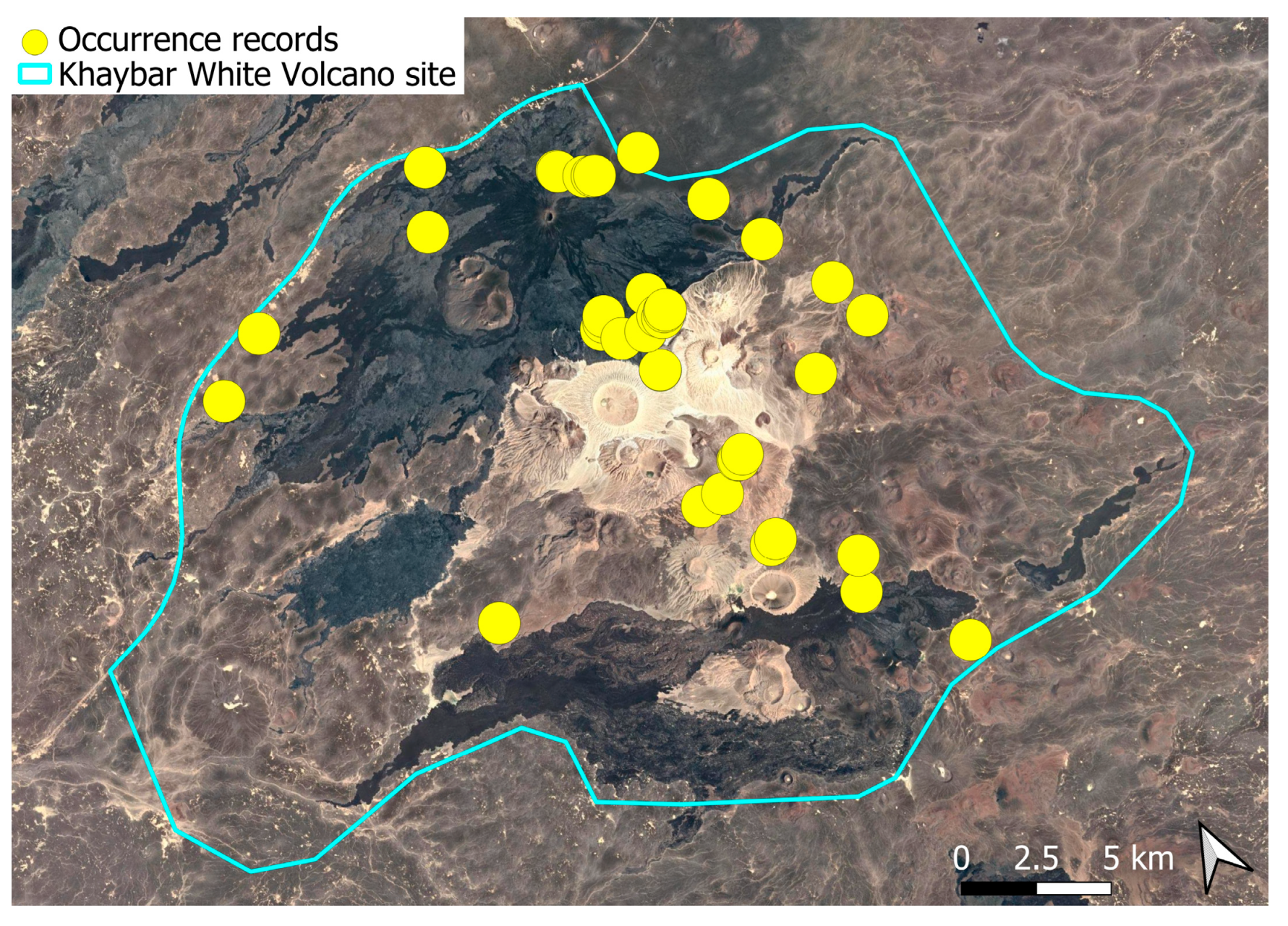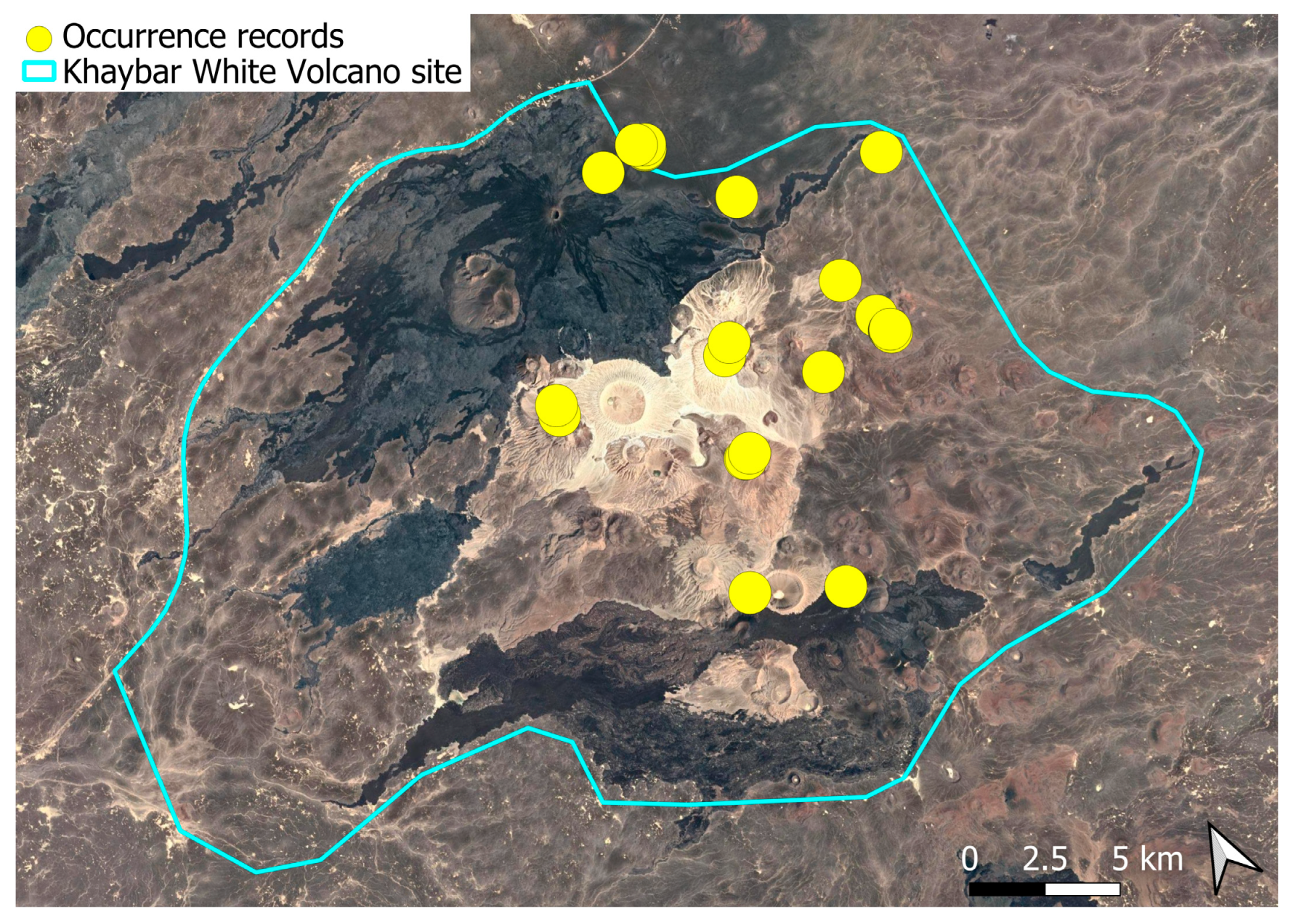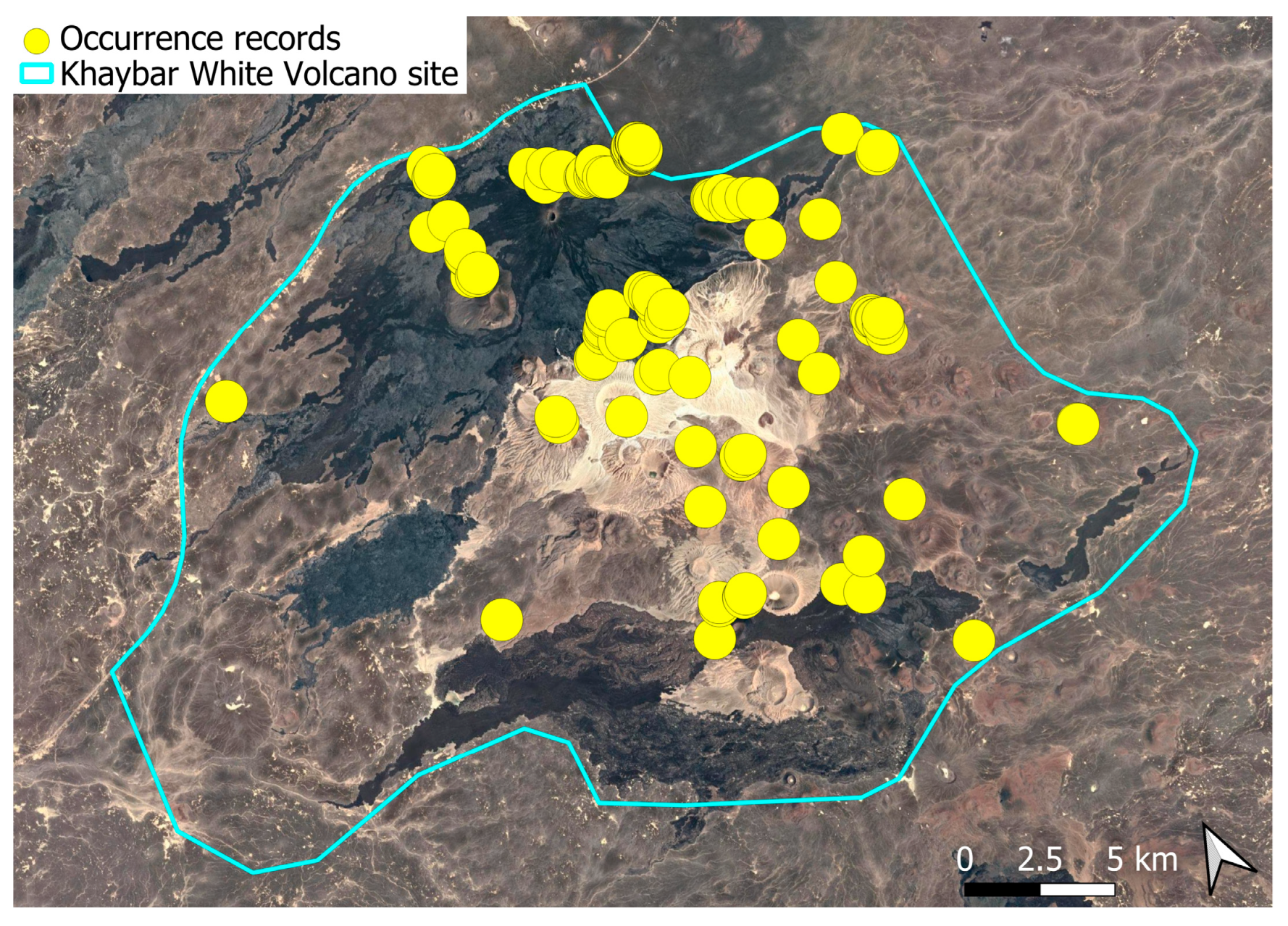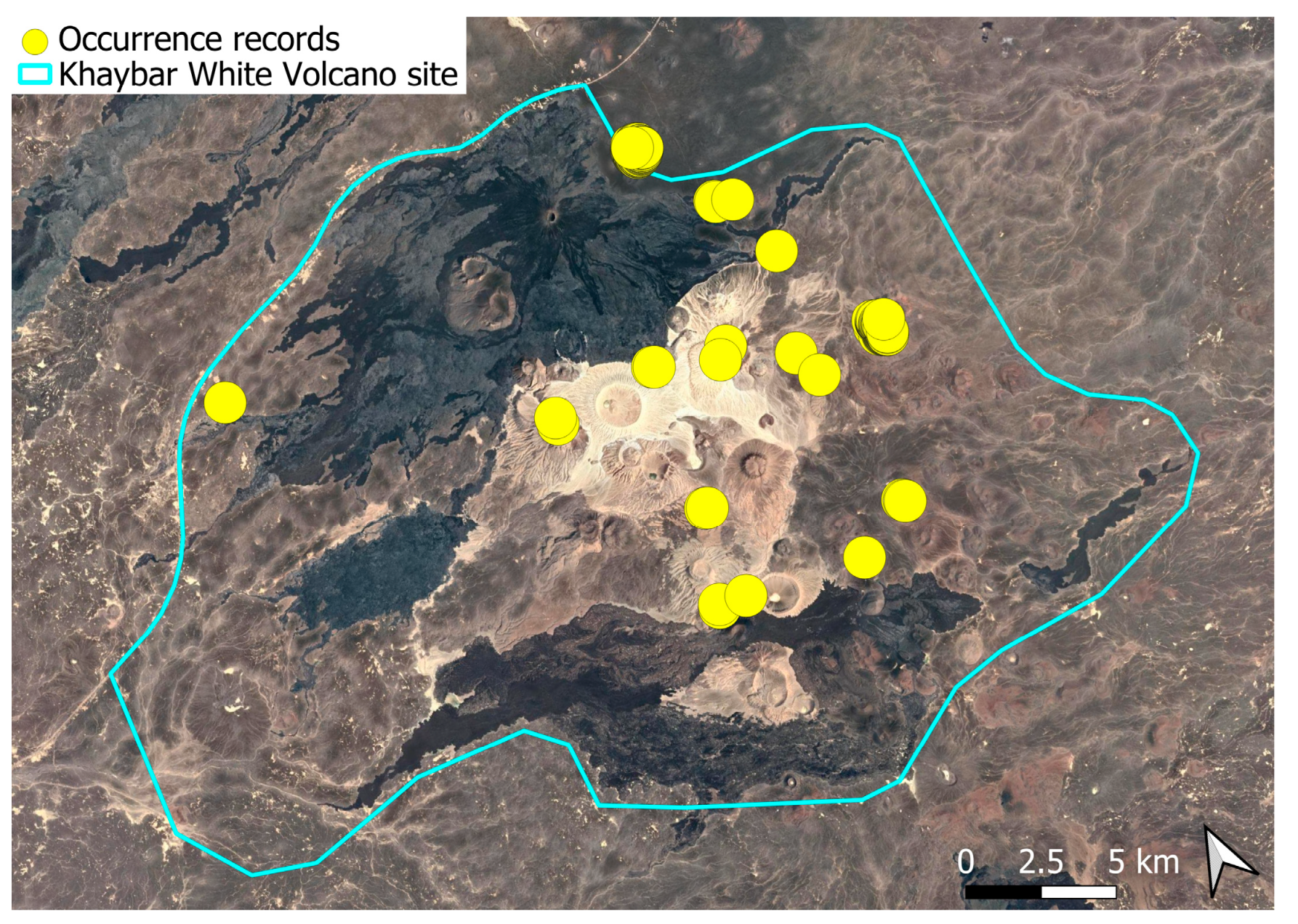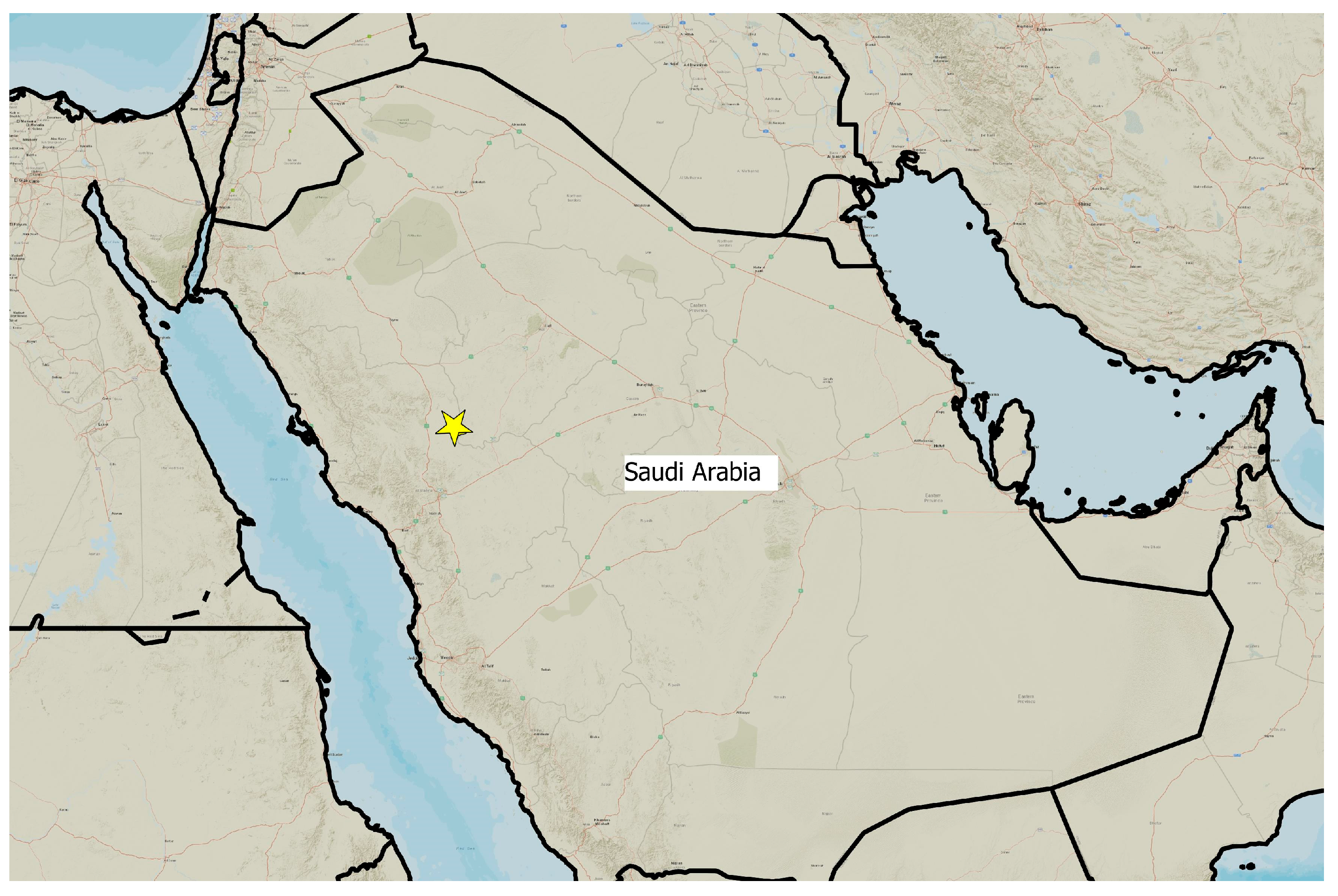2. Results
A total of fifty-one distinct taxa were observed, among which three (
Didymodon cf.
rigidulus,
Enthostodon cf.
commutatus, and
Fissidens cf.
arnoldii) are taxonomic uncertainties (
Table 1). This total represents 30% of the total bryophytes recorded in Saudi Arabia.
Six species previously unknown to the Arabian Peninsula (Anoectangium euchloron, Geheebia erosa, Molendoa sendtneriana, Pterygoneurum subsessile, and Ptychostomum torquescens) and six species newly recorded for Saudi Arabia (Anoectangium aestivum, Husnotiella revoluta, Syntrichia pagorum, Tortella nitida, Tortula lindbergii, and Tuerckheimia svihlae) were recorded in Khaybar White Volcano Geopark.
With only five species being recorded, liverworts were very rare in the studied area, with the vast majority of bryophytes being true mosses (90.2% of the taxa). Four species belonged to the complex thalloid order Marchantiales, with only one liverwort from the order Fossombroniales. Although leafy liverworts have been recorded in southwestern Saudi Arabia, the overall taxonomic profile remained quite comparable to that of the country, with 81% of records in Khaybar White Volcano Geopark being mosses.
Pottiaceae were highly dominant in the bryophyte flora, as they are throughout Saudi Arabia and in AlUla County [
6].
Funariaceae and
Bryaceae were also relatively well represented in Khaybar White Volcano Geopark, AlUla County, and the country. Overall, the family representation was very similar to that of AlUla County, with only two notable differences: the presence of one species from the Brachytheciaceae and one from the Fossombroniaceae.
The spatial distribution of bryophyte species richness across the Khaybar White Volcano Geopark is presented in
Figure 1. Floristic richness per 5 × 5 km grid cell varied markedly, ranging from 0 to 42 species.
Species richness was highest in the northeastern quadrant of the study area, with one grid cell hosting 42 species. Several surrounding cells also showed elevated richness (≥30 species), particularly those situated in the central-eastern portion of the site. In contrast, many peripheral cells, especially along the southern and southwestern margins, displayed low richness (fewer than six species or no bryophytes recorded).
A spatial comparison of values within the symbolic circles revealed a positive correspondence between total bryophyte richness and the number of tropical and high heritage value species. Grid cells exhibiting the highest total species counts (≥30 species; dark red shading) consistently contained elevated numbers of both tropical taxa (up to 8) and high heritage value taxa (up to 13). This pattern was particularly evident in the northeastern and central-eastern parts of the Khaybar White Volcano Geopark. Conversely, cells with low overall species richness (white or light grey shading; <6 species) generally lacked tropical and heritage species, with most of these cells displaying zeros across both categories.
Tropical species were mainly recorded in the central and eastern parts of the site, with a maximum of 8 tropical taxa observed in a single grid cell. High heritage value species occurred in several grid cells, reaching a peak of 13 species in one northeastern cell.
2.1. Aloina rigida (Hedw.) Limpr. (Pottiaceae)
A xerothermic Pangean species, widely distributed across the Arabian Peninsula, occurring in various arid and semi-arid habitats [
3]. In the Khaybar White Volcano Geopark area, its distribution was sparse and discontinuous. Populations were few and spatially constrained (only 12 observations, see
Figure 2). Nevertheless, fertile individuals were commonly observed.
Taxonomic determination remained challenging due to the difficulty in observing critical diagnostic characters, such as the differentiated hyaline leaf margin and the relatively thick stereid band. No noteworthy morphological variability was detected among the collected specimens.
Ecologically, this primarily terricolous species shows moderate specialization for dry, open habitats with minimal vegetation cover. This species was seen on older, eroded lava surfaces and was not recorded from the fresh basalt lavas. It preferentially colonized earthy banks, especially along wadi systems. Though occasionally observed on rock faces and volcanic slopes, these saxicolous occurrences appeared secondary and opportunistic.
2.2. Anoectangium aestivum (Hedw.) Spruce (Pottiaceae)
A subcosmopolitan species with a distinct high montane character, known in the Arabian Peninsula only from a few records in southern Asir of Yemen, at around 2000 m elevation [
16]. It was rare, found in the north-eastern part of Khaybar White Volcano Geopark and just outside the area (
Figure 3). Local populations were consistently small and weakly developed, and always occurred in association with
A. euchloron, which was typically much more abundant. No sexual organs or sporophytes were observed.
The species is strictly saxicolous, confined to unstable volcanic slopes in fumarolic zones.
2.3. Anoectangium euchloron (Schwägr.) Spruce (Pottiaceae)
A pantropical species not previously recorded in the Arabian Peninsula,
A. euchloron was found in the eastern half of the Khaybar White Volcano Geopark, exclusively on fumarolic volcanic slopes (
Figure 4). While its distribution remained highly localized, it was frequent within its specialized microhabitat. Local populations were often well developed, sometimes covering several tens of cm
2, and occasionally extending up to one square meter under favorable conditions. The species was entirely sterile, with no gametangia observed, like in
A. aestivum.
Morphologically,
A. euchloron is a highly distinctive species, readily identifiable in the field even within mixed stands with
A. aestivum. Its consistently contorted leaf posture when dry, reminiscent of the genus
Barbula, contrasts clearly with the feebly incurved, appressed leaves of
A. aestivum. These characters show no observed intermediates, reinforcing its taxonomic validity despite Zander’s [
17] proposed synonymy with
A. aestivum. Based on field and herbarium observations from the Khaybar White Volcano Geopark area, we support the recognition of
A. euchloron as a separate species, in agreement with the ecological and morphological distinctions highlighted by Arts & Sollman [
18] in Ecuador. Although rhizoidal tubers were reported as a distinguishing trait in that study, we did not observe them in our material despite targeted investigation.
Ecologically, the species is strictly saxicolous, exclusively restricted to thermally influenced volcanic habitats (fumaroles).
2.4. Bryum dichotomum Hedw. (Bryaceae)
This cosmopolitan species is widely distributed across the Arabian Peninsula and is also abundant throughout the Khaybar White Volcano Geopark (
Figure 5). It is by far the most frequently recorded bryophyte in the area. Although most populations were restricted to a few square centimeters, more extensive colonies—sometimes spanning several square meters—were recorded, particularly in lava flows where conditions appeared especially favorable. No gametangia or sporophytes were observed in the region, but vegetative propagation appears to be the dominant mode of reproduction, as similarly noted at the AlUla site [
6].
A broad taxonomic framework was applied here for
Bryum dichotomum, following the interpretation proposed in [
19].
The species demonstrates considerable ecological plasticity and is primarily terricolous, typically occurring in earthy substrates, temporary grasslands, and flood-prone zones. It is also commonly found in semi-protected niches such as animal burrow entrances, beneath lava slabs, or near cave mouths.
2.5. Crossidium aberrans Holz. & E. B. Bartram (Pottiaceae)
A circum-Tethyan species, widespread and often locally abundant across the Arabian Peninsula [
3]. In the Khaybar White Volcano Geopark, it was moderately frequent (
Figure 6). Populations were generally well developed and comparatively extensive relative to other species sharing similar ecological niches. Fertile individuals were only occasionally observed.
Taxonomic resolution within the genus
Crossidium remains incomplete, and specific populations in the region pose identification challenges, as discussed in Hugonnot et al. [
6]. Despite these uncertainties, the populations observed in Khaybar exhibited consistent traits compatible with the species concept adopted here.
Ecologically, the species is primarily terricolous, favoring dry, mineral-rich soils. It typically colonizes earthy microhabitats and sheltered soil accumulations beneath boulders, but is also found in partially exposed sites such as screes and lava flows.
2.6. Crossidium crassinervium (De Not.) Jur. (Pottiaceae)
This circum-Tethyan species is broadly distributed and frequently locally abundant across the Arabian Peninsula [
3]. In the Khaybar White Volcano Geopark, it was frequent in suitable microhabitats (
Figure 7). Populations were generally well developed and often more extensive than those of co-occurring species. Fertile specimens were only occasionally encountered.
Primarily terricolous, this species exhibits notable ecological flexibility, colonizing a range of dry, open habitats. It is frequently found on soil accumulations beneath boulders or along banks, but also establishes on rocky substrates, including screes, lava flows, and outcrops.
2.7. Crossidium deserti W. Frey & Kürschner (Pottiaceae)
A widely distributed circum-Tethyan element, frequently exhibiting local abundance in the Arabian Peninsula [
3]. In the Khaybar White Volcano Geopark, it was localized and rare mainly in the northern part of the area (
Figure 8), and generally formed relatively small populations, especially in comparison to many other congeners. Fertile individuals were only occasionally observed.
Despite the number of studies devoted to the genus
Crossidium [
20,
21,
22], its taxonomy remains uncertain and would benefit from a re-evaluation using molecular approaches. The status of
C. deserti in particular remains ambiguous and warrants further investigation.
Ecologically, the species is specialized for dry, fully exposed habitats. It is predominantly terricolous, growing in loose, mineral-rich soils and in earthy pockets beneath stones, but also occurs in fissures and on fractured volcanic rock surfaces.
2.8. Crossidium squamiferum (Viv.) Jur. (Pottiaceae)
A circum-Tethyan species, widespread and often locally abundant across the Arabian Peninsula [
3]. In the Khaybar White Volcano Geopark (
Figure 9), this species was frequent and was one of the most vigorous and productive, forming substantial cushions and establishing larger populations than most other taxa occupying similar habitats. Sporophytes were occasionally produced, but typically in small numbers.
Ecologically, this species displays a mixed substrate preference. It can be found on both basalt lava and comendite volcanoes, thriving in rocky environments—such as fissures, outcrops, and block faces—and in earthy microsites, particularly in soil pockets protected beneath stones.
2.9. Didymodon cf rigidulus Hedw. (Pottiaceae)
A xerothermic Pangean species, rare but seemingly widespread across the Arabian Peninsula [
3]. In and just outside Khaybar White Volcano Geopark, it was relatively frequent but of restricted occurrence, mainly in the northeastern part of the site (
Figure 10). Populations were often locally abundant, forming extensive mats on suitable substrates. While always sterile, the presence of leaf axil gemmae indicated vegetative reproduction as the dominant strategy.
Morphologically, the material observed in this area showed several deviations from the typical concept of Didymodon rigidulus. Notably, plants displayed a characteristic habit with spreading basal leaves that become erect and acuminate toward the apex. The leaves were predominantly unistratose, occasionally bistratose at the tip, and the basal laminal cells were short and nearly isodiametric. These traits raised questions about the taxonomic circumscription of the species and suggested that further study was needed to clarify its identity.
Ecologically, the species is strictly saxicolous, confined to thermally influenced or highly mineral substrates, including looser material on volcanic slopes, and barren outcrops.
2.10. Didymodon desertorum (J. Froehl.) J. A. Jiménez & M. J. Cano (Pottiaceae)
This circum-Tethyan taxon is relatively widespread across the Arabian Peninsula [
3] and was frequent in and just outside Khaybar White Volcano Geopark (
Figure 11). It was often inconspicuous within its populations, typically represented by only a few scattered stems. Although archegonia were occasionally observed, sporophytes have never been recorded, and populations consist exclusively of sterile individuals.
Ecologically, the species exhibits considerable versatility, occupying a broad range of dry microhabitats on various geological substrates. While predominantly saxicolous—common on rock faces, exposed slopes, and fissures—it is also found in more terricolous contexts, such as earthy banks and soil pockets beneath stones, especially within wadi systems.
2.11. Entosthodon cf commutatus Durieu & Mont. (Funariaceae)
A circum-Tethyan, Mediterranean species, apparently widespread across the Arabian Peninsula based on unpublished records.
Entosthodon cf.
commutatus was previously discussed in Hugonnot et al. [
6] and was very frequently encountered in and just outside Khaybar White Volcano Geopark, where it seemed to avoid the central part of fresh basalt and was rarely found on the comendite volcanoes (
Figure 12). Populations were often extensive, and unlike observations from AlUla [
6], sporophytes were frequently produced, often abundantly so, especially in more humid microsites.
It is likely often confused with Entosthodon attenuatus (Dicks.) Bryhn, a species considered relatively common in Saudi Arabia, but not observed during our surveys. In contrast, E. cf. commutatus was regularly found and identified based on its diagnostic features: a long but non-excurrent nerve, pale brown rhizoids (never cherry red), and a capsule with a broad mouth when dry, and a well-developed peristome.
Ecologically, the species is mainly terricolous, occupying loose to compacted soils in dynamic, periodically disturbed habitats such as wadis, flood-prone lava fields, and earthy slopes. It also occasionally colonizes fissured rocks and fumarolic zones.
2.12. Enthostodon muhlenbergii (Turner) Fife (Funariaceae)
A circum-Tethyan species moderately distributed across the Arabian Peninsula, but relatively rare [
3]. It was rarely observed, mainly in the north-eastern and central parts of the Khaybar White Volcano Geopark, with isolated occurrences in the west (
Figure 13). It was typically encountered in low densities and was mostly sterile, its sporophytes being very rarely formed.
Ecologically, the species is primarily terricolous, favoring protected soil pockets beneath stones and within wadi systems. It is also occasionally found in rocky canyons and on older, eroded lava fields, but does not appear to establish on the fresher basalt lava flows.
2.13. Fissidens cf. arnoldii R. Ruthe (Fissidentaceae)
A circum-Tethyan species,
Fissidens cf.
arnoldii is broadly distributed across the Arabian Peninsula, including hyper-arid regions [
3]. In contrast, it was moderately frequent within and just to the north of the Khaybar White Volcano Geopark (
Figure 14), where it occurred only sporadically and in low abundance. The sporophytes were very rare.
Firmly established in the regional flora since the publication of [
23], this species exhibits morphological differences from typical European
Fissidens arnoldii, as previously noted [
6] and confirmed during our own observations. The presence of morphologically similar taxa in parts of Asia further supports the need for a thorough taxonomic reassessment. Field populations were often sterile and morphologically reduced, complicating identification.
Ecologically, the species is distinctly terricolous, with a strong affinity for protected or humidified microsites. It typically grows on fine soils within wadis, along earthy banks, and beneath boulders, though it may occasionally occur in rock fissures, shaded canyons, and fumaroles.
2.14. Fissidens sciophyllus Mitt. (Fissidentaceae)
A paleotropical species, with its northernmost population in southwestern Arabia just below 20° latitude [
3], making the occurrence in and just outside the Khaybar White Volcano Geopark a highly isolated outpost. It was moderately frequent and restricted to fumarolic zones (
Figure 15). Populations were minute, consisting of a few, poorly developed, and consistently sterile individuals—no gametangia or sporophytes were observed.
The taxon is currently placed within
sciophyllus Mitt., a morphologically heterogeneous group. The “
arabicus-expression”, initially described as an independent species [
24], is characterized by relatively short costae. However, costal length is known to vary broadly within the species complex, which clearly requires taxonomic revision.
Ecologically, this species is highly specialized, strictly limited to saxicolous microhabitats under geothermal influence.
2.15. Fissidens crispus Mont. (Fissidentaceae)
A circum-Tethyan species, scattered and rare across the Arabian Peninsula. At the Khaybar White Volcano site, it was scarce and confined exclusively to fumarolic zones (
Figure 16). The population detected was of minimal extent and comprised very few individuals. Sporophytes were rare, but all observed sporophyte-bearing specimens were unequivocally assigned to this species.
Ecologically, the species is strictly saxicolous, restricted to geothermal volcanic slopes and fumaroles.
2.16. Fossombronia caespitiformis (Raddi) De Not. ex Rabenh. subsp. caespitiformis (Fossombroniaceae)
A circum-Tethyan liverwort, scattered and rare across the Arabian Peninsula, primarily along the Red Sea corridor [
3]. In and just to the north of the Khaybar White Volcano Geopark, it was moderately frequent, and confined exclusively to fumarolic zones (
Figure 17). Populations were tiny, often limited to just a few shoots, and appeared to persist at the edge of edaphic moisture tolerance. Fertile individuals were rare.
All observed spore-bearing specimens were unequivocally assigned to this species. Additionally, vegetative characters proved stable across all collections. Notably, this is the only non-Marchantioid liverwort recorded in the area.
Ecologically, the species is strictly saxicolous, restricted to geothermal volcanic slopes and fumaroles.
2.17. Funaria hygrometrica Hedw. (Funariaceae)
A sub-cosmopolitan species widely distributed in southwestern Asia,
Funaria hygrometrica was previously known to the Arabian Peninsula only through a record in Kuwait [
5], until its recent discovery in Saudi Arabia, where it had evidently been neglected [
6]. It remained scarce at the local scale (
Figure 18). Despite its limited occurrence, populations were often well developed and freely fertile, with regular production of sporophytes.
Ecologically, this species is clearly terricolous, favouring disturbed, nutrient-rich soils in environments subject to transient moisture. It typically colonizes earthy patches in grasslands, entrances of animal burrows, and flood-prone zones.
2.18. Geheebia erosa (J.A. Jiménez & J. Guerra) J.A. Jiménez & M.J. Cano (Pottiaceae)
A xerothermic Pangean species not previously recorded in southwestern Asia. In the Khaybar White Volcano Geopark, it was scarce as it was found in a single, spatially restricted locality (
Figure 19), with minimal population size and number of individuals. All observed specimens were completely sterile, though the presence of rhizoidal tubers was confirmed.
Geheebia is a recently segregated genus from the broad and morphologically diverse
Didymodon complex, based on both morphological characters and multilocus phylogenetic analyses [
25]. The delimitation of the
Didymodon tophaceus complex has also been revised [
26], highlighting substantial morphological overlap and ITS-based non-monophyly. Accordingly,
G. siccula and
G. erosa have been proposed as subspecies of
G. tophacea. However, following the framework of [
5], we provisionally maintain these taxa as separate species due to their consistent morphological distinctiveness.
Ecologically, this moss is strictly terricolous, restricted to earthy banks at wadi margins. It shows a clear preference for mineral soils periodically affected by surface runoff and seasonal moisture input.
2.19. Grimmia capillata De Not. (Grimmiaceae)
A circum-Tethyan taxon previously unrecorded on the Arabian Peninsula, even when
G. mesopotamica Schiffn. is considered a synonym, an option rejected by Kürschner & Frey [
5].
Grimmia capillata is known from a single population in the Khaybar White Volcano Geopark, where it was obviously scarce (
Figure 20). Although not abundant overall, it formed several well-structured cushions within its restricted locality. The species was fully fertile, with well-developed sporophytes.
G. capillata is not generally considered morphologically close to
G. orbicularis, yet distinguishing the two can be challenging in the field in the local context, primarily because of the unusual, very short seta of the latter. In the regional area,
G. orbicularis lamina is consistently pluristratose, with uniformly pilose leaves and no clear differentiation between proximal and perichaetial leaves [
6]. In contrast,
G. capillata is characterized by a catenulate arrangement of reduced, epilose proximal leaves, sharply transitioning to pilose, slightly membranous perichaetial leaves. According to Maier [
27], these upper leaves may sometimes appear less hyaline. The capsule morphology also aids in separation: in
G. capillata, the annulus persists even in mature capsules, and the peristome teeth are broadly triangular with at most three divisions. In
G. orbicularis, the annulus is deciduous, the teeth are more rectangular, typically divided into four parts, and often show anastomosing patterns.
Ecologically, this species is strictly saxicolous, restricted to volcanic slopes and bare rocky outcrops. It demonstrates a strong affinity for hard, exposed substrates in arid environments, likely benefiting from low competition and intense solar radiation.
2.20. Grimmia orbicularis Bruch ex Wilson (Grimmiaceae)
A northern species with an apparent Mediterranean affinity,
Grimmia orbicularis was far more frequent and widespread than related taxa in and just outside the Khaybar White Volcano Geopark (
Figure 21). Its populations were generally well developed and often locally abundant. Sporophytes were frequently present, though rarely produced in large numbers.
Our observations confirm the broad morphological variability previously documented in AlUla County [
6], encompassing differences in leaf structure and pigmentation within and between populations.
Ecologically, this species is a typical saxicolous moss, thriving across a wide range of rocky microhabitats. It is commonly found on outcrops, block faces, fissures, cliff systems, and consolidated pozzolanic deposits. It also occurs in transitional microsites, such as earthy zones beneath stones and within wadis.
2.21. Gymnostomum calcareum Nees & Hornsch. var. calcareum (Pottiaceae)
Gymnostomum calcareum is a cosmopolitan species, relatively widespread across the Arabian Peninsula [
3], though only moderately frequent in and just outside the Khaybar White Volcano Geopark (
Figure 22). At this site, it was observed in limited populations. Compared to
G. mosis, which can form expansive mats over several square meters in favourable conditions,
G. calcareum was less abundant and formed more restricted colonies. A single fertile occurrence (showing a colliculate exothecium) was recorded; gemmae were not observed.
Its long, ribbon-shaped, or ligulate leaves distinguish it morphologically within the local bryoflora.
Ecologically, this species is saxicolous, confined to volcanic slopes, fumarolic zones, and rocky habitats within wadis. None of the Gymnostomum species observed in the Geopark is associated with tufa-forming communities, which are virtually absent here.
2.22. Gymnostomum mosis (Lorentz) Jur. & Milde (Pottiaceae)
Gymnostomum mosis is a circum-Tethyan species, relatively widespread across the Arabian Peninsula [
3] and particularly well represented in Khaybar White Volcano Geopark, and just outside to the north (
Figure 23), where it was considerably more frequent and abundant than
G. calcareum. Its sporophytes were rare.
Fertile specimens of G. mosis display a cylindrical capsule with a colliculate exothecium, a distinct red rim composed of transversely elongated cells, and a long, rostrate operculum. Sterile individuals are characterized by the absence of gemmae, relatively short leaves, and irregular marginal stratosity, with some leaves exhibiting mostly unistratose margins. Leaf shape is somewhat variable; apices are typically rounded.
Ecologically, G. mosis is primarily saxicolous, growing on volcanic slopes, rocky outcrops, and mineral soils in wadis and fumarolic areas.
2.23. Husnotiella revoluta Cardot
A pantropical species,
Husnotiella revoluta is extremely rare on the Arabian Peninsula, with a single record in Yemen, near San‘a’ (Wadi Dahr, 2200 m) [
28]. The population found in and just outside the Khaybar White Volcano Geopark area (
Figure 24) represented a highly disjunct occurrence, isolated both geographically and ecologically. The species was very scarce locally. All observed material was completely sterile, with no sporophytes present.
Local populations exhibited morphological variability well beyond what was documented by Jiménez et al. [
28], confirming instead the broader polymorphism historically associated with this taxon. The leaves were oblong, rounded at the apex, with a distally dilated costa that extended laterally into the lamina, penetrating the foliar tissue—traits consistent with classical descriptions of the species.
Ecologically, this moss is strictly saxicolous, growing on volcanic slopes near fumarolic zones.
2.24. Hymenostylium hildebrandtii (Müll. Hal.) R. H. Zander (Pottiaceae)
This Paleotropical species is rare across the southwestern Arabian Peninsula [
29] and has been recorded in Makkah Province [
30], but was very rare within the Khaybar White Volcano Geopark and just to the north of the area (
Figure 25). It occurred in small, isolated populations. Sporophytes were not observed in the Khaybar region, although they are known from more southern populations. All local individuals are sterile.
Ecologically, the species is highly localized, favoring transiently moist microhabitats in erosion-prone wadi beds and fumaroles.
2.25. Microbryum davallianum (Sm.) R.H. Zander (Pottiaceae)
A circum-Tethyan species considered relatively frequent across the Arabian Peninsula [
3], though typically under-recorded due to taxonomic difficulties associated with the genus. In and just to the north outside the Khaybar White Volcano Geopark area, it was scarce and of isolated occurrence (
Figure 26). It was also surprisingly much less abundant than the other local species of the same genus. Sporophytes were commonly produced, but their diagnostic value was limited. Frequent developmental abortion prevented reliable spore observation, resulting in a substantial amount of undetermined or uncertain material across collections.
Microbryum species are classic pioneers, quickly colonizing bare, compacted substrates where competition is minimal. This species is no exception, being strictly terro-saxicolous and confined to geothermal habitats such as fumaroles and unstable volcanic slopes.
2.26. Microbryum starckeanum (Hedw.) R.H. Zander (Pottiaceae)
Microbryum starckeanum is a cosmopolitan species considered relatively frequent across the Arabian Peninsula [
3] and was among the most commonly encountered bryophytes in and just outside the Khaybar White Volcano Geopark (
Figure 27). Its frequent occurrence and often high abundance made it one of the characteristic components of the local bryoflora. The sporophytes were frequently produced, but they often aborted (see
M. davallianum).
Reflecting its ecological flexibility, M. starckeanum is observed across a range of contrasting habitats. It is predominantly terricolous, favouring earthy banks, flood-prone soils, and sheltered pockets beneath stones. However, it also readily colonizes transitional and partially saxicolous environments such as screes, lava flows, and rock fissures.
2.27. Molendoa sendtneriana (Bruch & Schimp.) Limpr. (Pottiaceae)
This species corresponds to a pantropical chorological element. It was scarce in the Khaybar White Volcano Geopark. Although it has not been previously reported in Saudi Arabia or the Arabian Peninsula, it is, in fact, frequent (pers. obs.) in the Asir mountain range, where it occurs in rocky and often wooded wadis. Its apparent absence from regional floristic inventories likely results from previous oversight. It is also known from a broad intercontinental range, including Europe, Northeast and Eastern Asia, Tropical Africa, North, Central, and South America [
31]. The species was found in a single micro-population, consisting of a few poorly developed individuals just outside Khaybar White Volcano Geopark (
Figure 28). No sporophytes were observed; all individuals were sterile.
Misidentifications are likely due to the difficulty of observing key taxonomic characters, especially the presence of highly reduced lateral branches bearing female gametangia [
31]. Anatomically, the costa contains two stereid bands [
32].
Ecologically, the species is strictly saxicolous, with its occurrences restricted to fumarolic environments.
2.28. Plagiochasma eximium (Schiffn. ex Steph.) Steph. (Aytoniaceae)
A Palaeotropical taxon with a tropical African distribution, this species is known from the mountainous Asir region in southwestern Arabia, with its northernmost historical record near the latitude of Makkah [
3]. The population just outside the Khaybar White Volcano Geopark represents the northernmost occurrence of the species within its Afro–Southwest Asian range. Outside Ethiopia, where it is more widespread [
33], the species remains rare. It was scarce locally (
Figure 29). The species was fertile locally.
Its taxonomy is challenging, and it may be confused with
P. beccarianum Steph. However in the Khaybar material, it was distinguished by a thallus exceeding 6 mm in width, narrowly oblong-lanceolate appendages on the ventral scales, and elaters that were either spiral-less or possess interrupted spirals. This contrasts with
P. beccarianum, which has a smaller thallus (less than 5 mm), triangular, attenuate scales, and consistently spiraled elaters [
33].
Ecologically, this liverwort is highly specialized and strictly saxicolous, restricted to fumarolic zones. The species has also been previously reported elsewhere from volcanic caves [
33].
2.29. Plagiochasma rupestre (J. R. Forst. & G. Forst.) Steph. (Aytoniaceae)
This xerothermic Pangean taxon is one of the most frequent and abundant marchantioid liverworts across the Arabian Peninsula. However, its presence in the Khaybar White Volcano Geopark was surprisingly very rare (
Figure 30), mirroring observations in AlUla County [
6]. This scarcity contrasted with its regional ubiquity and raises questions about local ecological constraints [
6]. In the Khaybar White Volcano Geopark,
Plagiochasma rupestre was found in minimal numbers, with only a few thalli observed in rock fissures. Some individuals were fertile, bearing carpocephala.
Ecologically, the species is saxicolous, favoring shaded or semi-exposed rocky microsites on cliff ledges and soil-filled crevices beneath boulders.
2.30. Pterygoneurum subsessile (Brid.) Jur. (Pottiaceae)
A xerothermic Pangean species with a distinctly northern character, previously known only in Israel and Turkey [
5], and newly recorded for the Arabian Peninsula. In the Khaybar White Volcano Geopark, this rare species was observed in a few localized populations (
Figure 31). Nonetheless, some populations were well established and could cover several square meters, sometimes forming nearly pure stands. Despite being fully fertile, sporophyte development was often abortive, limiting effective sexual reproduction.
Ecologically, the species is strictly terricolous, confined to bare or sparsely vegetated soil patches, particularly within young lava fields.
2.31. Ptychostomum pseudotriquetrum (Hedw.) J.R.Spence & H.P.Ramsay (Bryaceae)
A sub-cosmopolitan species, recently discovered on the Arabian Peninsula in southwest Yemen [
34] and more recently in AlUla County, where it remains uncommon [
6]. In and just outside the Khaybar White Volcano Geopark, it was similarly rare (
Figure 32), with populations limited to a small number of diminutive individuals. All observed material was sterile.
Ecologically, this moss is predominantly saxicolous, growing on consolidated volcanic substrates, lava flows, and rocky canyon walls. It also occurs in transitional microsites such as soil-filled crevices beneath boulders and within scree deposits.
2.32. Ptychostomum torquescens (Bruch & Schimp.) Ros & Mazimpaka
A subcosmopolitan species not previously recorded in the Arabian Peninsula [
19]. In and just outside the Khaybar White Volcano Geopark, it was common and even locally abundant, particularly in fumarolic zones (
Figure 33), where it formed well-developed colonies composed of robust, fully fertile individuals. Gametangia were frequently observed, while sporophytes were rare.
The species is known to be synoicous, though this condition is not consistently expressed. Many colonies exhibit a mixture of unisexual buds—potentially leading to confusion with the dioicous
P. capillare—and synoicous inflorescences, highlighting some variability in reproductive expression. This was previously underlined by Syed [
35].
Ecologically, the species is strictly saxicolous and strongly associated with geothermal habitats. It is confined to fumaroles and volcanic slopes.
2.33. Riccia cavernosa Hoffm. (Ricciaceae)
This cosmopolitan species, of xerothermic Pangean origin, is widely distributed across the Arabian Peninsula, with a notable concentration of records along the Red Sea coast [
3]. In the Khaybar White Volcano Geopark, however, it was moderately frequent due to the scarcity of suitable habitats, which were only present in the southwestern part (
Figure 34). The populations were small (several tenth of thalli). Remarkably, the species almost always produced sporophytes, even when individuals were highly reduced and measured only a few millimeters in size.
As previously noted in AlUla County [
6], the taxonomic identity of the local populations warrants further investigation, as subtle morphological variation suggests possible regional differentiation.
Ecologically, this liverwort is strictly terricolous, confined to transient soil habitats such as sandy wadi banks and exposed mudflats.
2.34. Scorpiurium circinatum (Brid.) M. Fleisch. & Loeske (Brachytheciaceae)
A circum-Tethyan (Mesogean) taxon,
Scorpiurium circinatum is strictly confined to the southwestern Arabian Peninsula. In and just outside the Khaybar White Volcano site, it was frequent (
Figure 35), and represented a notable biogeographical outlier, being the only pleurocarpous moss recorded north of the latitude of Makkah—excluding the Mediterranean
Fabronia pusilla [
3]. It was typically found in very small quantities, forming inconspicuous patches. The species was entirely sterile, with no sporophytes observed, and was frequently highly reduced vegetatively.
Ecologically, it is strictly saxicolous and closely linked to geothermal substrates, occurring exclusively on volcanic slopes in fumarolic zones.
2.35. Syntrichia caninervis Mitt. var. caninervis (Pottiaceae)
The genus
Syntrichia comprises mainly xerophytic species adapted to arid and semi-arid climates. Alongside
Tortula, this genus is the most species-rich in the Khaybar White Volcano Geopark, with five species represented.
Syntrichia caninervis var.
caninervis is a xerothermic Pangean taxon, widely distributed across the Arabian Peninsula [
3]. In the Khaybar region (
Figure 36), it was rare, and occurred in the form of diminutive individuals, forming tiny and scattered colonies. It was entirely sterile there.
Ecologically, this moss is primarily terricolous, typically colonizing bare mineral soil within lava fields and nearby earthy microsites.
2.36. Syntrichia fragilis (Taylor) Ochyra (Pottiaceae)
A pantropical species with a relictual Tertiary xerotropical affinity,
Syntrichia fragilis is known from the Asir Mountains in Yemen and Saudi Arabia, but had not previously been recorded north of the latitude of Makkah [
3]. Just outside the boundary to the Khaybar White Volcano Geopark, it was very rare, being represented by a single colony (
Figure 37) observed in a fumarolic zone. It occurred in very low quantities and in a highly reduced vegetative state. The species was entirely sterile.
Ecologically, S. fragilis is strictly saxicolous, confined to exposed, mineral-rich rock surfaces on volcanic slopes, within fumaroles.
2.37. Syntrichia laevipila Brid. (Pottiaceae)
A circum-Tethyan species confined to the southwestern Arabian Peninsula, where it is rare and primarily corticolous, growing on
Juniperus excelsa and
Acacia origena in escarpment woodlands [
20]. It was rare in and just outside the Khaybar White Volcano Geopark (
Figure 38). Plants were vegetatively reduced, forming very small, inconspicuous colonies that are difficult to detect in the field. It was locally entirely sterile, with no sporophytes observed.
Although principally corticolous outside Khaybar, this species is also moderately saxicolous here, occurring on volcanic slopes, lava flows, and rocky outcrops, and occasionally extending into nearby earthy microsites.
2.38. Syntrichia pagorum (Milde) J.J. Amann (Pottiaceae)
A subcosmopolitan taxon traditionally reported as corticolous, but observed here in a saxicolous context. In the Khaybar White Volcano Geopark (
Figure 39), the species was very rare, occurred in very small quantities, and was consistently sterile.
From a taxonomic perspective, it remains a controversial entity. However, following Kürschner & Frey [
5], it is here treated as a distinct species, particularly as it occurs independently from
Syntrichia laevipila, with which it is often confused. The constant presence of gemmae supports its recognition as a separate taxon. Nonetheless, this is a morphologically complex group, and its taxonomy within the Arabian Peninsula remains in need of thorough revision [
36].
Ecologically, the species is primarily terricolous, typically occupying sheltered soil pockets beneath boulders, in lava flows, or near cave entrances.
2.39. Syntrichia rigescens (Broth. & Geh.) Ochyra (Pottiaceae)
Syntrichia rigescens is a circum-Tethyan species previously recorded in Israel, Jordan, and Syria [
5,
37], and recently reported for the first time on the Arabian Peninsula in Hugonnot et al. [
6]. It was rare and localized in the Khaybar White Volcano Geopark (
Figure 40). Colonies were small and scattered, rarely covering more than 100 cm
2 in a single patch, and were typically found in isolated occurrences. All observed individuals in the area were sterile.
Nevertheless, identification remains possible based on vegetative features [
38,
39]. Determination can be particularly challenging in the absence of gemmae, especially with respect to
S. handelii, a species not yet recorded in the Arabian Peninsula. However, in
S. rigescens, gemmae are almost always present, though often restricted to older leaves or confined to a small portion of the foliage. A distinguishing feature is the more strongly hispid dorsal surface of the costa in
S. rigescens.
Ecologically, this species ranges from saxicolous to sub-terricolous, occupying exposed rocky substrates such as consolidated pozzolanic deposits, fissures, and lava flows, as well as nearby mineral soils.
2.40. Targionia hypophylla L. (Targioniaceae)
T. hypophylla is a xerothermic Pangean taxon widespread on the Arabian Peninsula [
3], though rare in and just outside Khaybar White Volcano Geopark (
Figure 41). Populations were generally extremely sparse. Sporophyte production was occasional.
The genus
Targionia has been the focus of detailed taxonomic studies on the Arabian Peninsula [
40,
41], leading to the description of the endemic subspecies
Targionia hypophylla subsp.
linealis. Despite targeted fieldwork in the Khaybar White Volcano Geopark, this subspecies was not observed. As emphasized by Hugonnot et al. [
6], a comprehensive taxonomic reassessment of
Targionia is warranted, particularly through the application of molecular tools to resolve existing ambiguities.
Ecologically, this liverwort is strictly saxicolous, occurring on volcanic slopes, exposed outcrops, and within fumarolic zones.
2.41. Timmiella barbuloides (Brid.) Mönk. (Pottiaceae)
This circum-Tethyan species is among the few bryophytes widely distributed across the Arabian Peninsula, particularly in the western Hijaz, Asir [
3], and western AlUla County. In and just outside the Khaybar White Volcano Geopark, it was frequent and even locally abundant (
Figure 42). Sporophytes were extremely rare, consistent with observations in AlUla [
6].
In the few fertile collections, the species was confirmed to be paroicous, while all sterile material was likewise confidently assigned to the same taxon based on stable vegetative features. The only other representative of the genus in the Peninsula is
T. anomala (Bruch & Schimp.) Limpr., known only in Kuwait [
5].
Ecologically, the species is predominantly saxicolous, most often found on rock fissures, canyon walls, and mineral-rich surfaces. It also colonizes earthy microsites beneath boulders in lava fields and fumaroles.
2.42. Tortella nitida (Lindb.) Broth. (Pottiaceae)
A circum-Tethyan species, this moss is rare across the Arabian Peninsula, with scattered records in the southwestern Asir Mountains (including Yemen), Socotra, and the United Arab Emirates [
5]. In and just outside the Khaybar White Volcano Geopark (
Figure 43), it was very frequent but spatially restricted. It occurred only in small tufts covering just a few square centimeters. It was consistently sterile, with no sporophytes observed.
Ecologically, the species is strictly saxicolous and displays a very narrow ecological amplitude. It is almost confined to fumarolic substrates in volcanic slopes.
2.43. Tortula atrovirens (Sm.) Lindb.
Five species of the genus
Tortula have been recorded in this County. While members of this genus are more or less widespread across the Arabian Peninsula, they tend to be more abundant in mountainous regions such as the Asir, the Hijaz, and the cuesta of Jabal Tuwayq [
3].
T. atrovirens is a xerothermic Pangean element. In and just outside the Khaybar White Volcano Geopark,
Tortula atrovirens was of particular significance due to its frequency (
Figure 44) and abundance. It produced sporophytes only occasionally.
Ecologically, it exhibits a broad amplitude, occurring on both earthy and rocky substrates. It is frequently found in rock fissures, canyon walls, and screes, but also in terricolous microhabitats such as earthy banks, flood-prone areas, and sheltered soil pockets beneath boulders.
2.44. Tortula inermis (Brid.) Mont. (Pottiaceae)
A circum-Tethyan species, this moss is widely distributed across the Arabian Peninsula, with records from Oman and various regions of Saudi Arabia [
3]. It was frequent and occurred mainly in the northeastern and central parts of Khaybar White Volcano Geopark (
Figure 45). Most populations consisted of only a few scattered individuals. It was occasionally fertile, with sporophytes observed sporadically.
Ecologically, the species is primarily saxicolous, favoring exposed rocky substrates such as block faces, screes, and fissures. It also extends into nearby earthy microhabitats, including soil patches and wadi beds.
2.45. Tortula lindbergii Kindb. ex Broth. (Pottiaceae)
A circum-Tethyan taxon with a northern character, this species is known in Kuwait and the UAE [
5], but remains rare and localized across the Arabian Peninsula. It was spatially localized and rare in Khaybar White Volcano Geopark (
Figure 46). Populations were typically well defined and locally abundant, often forming pure stands covering several square meters. Individuals within these patches were usually numerous and robust. It was often fertile, though sporophyte development frequently aborted before maturation.
The well-developed peristome is a key diagnostic feature and proves invaluable for reliable identification.
Ecologically, this moss is distinctly terricolous, mainly growing on soil patches in flood-prone lava fields, but also on screes, and sheltered earthy microsites beneath boulders.
2.46. Tortula mucronifera W.Frey, Kürschner & Ros (Pottiaceae)
An endemic species to the Arabian Peninsula and Jordan, this moss is relatively widespread across the Peninsula [
3,
42]. It was frequent in and just outside Khaybar White Volcano Geopark (
Figure 47). Populations remained consistently small, typically composed of only a few individuals. Sporophytes were frequently observed.
Ecologically, the species is terricolous to sub-saxicolous, most commonly found on earthy patches, at the base of rock faces, or beneath stones—particularly in wadis and among lava flows.
2.47. Tortula muralis Hedw. var. muralis (Pottiaceae)
A cosmopolitan taxon, this species appears to be rare in the Arabian Peninsula, with confirmed records only in Saudi Arabia—curiously absent from both Oman and Yemen [
5]. It was moderately frequent and of restricted occurrence in and just outside Khaybar White Volcano Geopark (
Figure 48). It was generally present as isolated tufts and was frequently observed with sporophytes.
In the area, it was stenotypic, occurring as a miniature expression, possibly reflecting adaptation to the region’s extreme aridity.
Ecologically, the species is highly versatile, colonizing a broad array of substrates including rock block faces, earthy banks, and soil patches in grasslands and wadis. It occupies both fully exposed lithic surfaces and more protected terricolous microsites.
2.48. Trichostomopsis australasiae (Hook. & Grev.) H. Rob. (Pottiaceae)
This is one of the most common bryophyte species in AlUla County and across the Arabian Peninsula [
3]. Like many xerophytic taxa, it is most frequently encountered in Jabal Tuwayq and the Asir Mountains. It belongs to a morphologically complex genus currently interpreted as containing only two species in the region, the other being
T. umbrosa (Müll. Hal.) H. Robins., which is far more restricted in distribution and known only in Saudi Arabia. This xerothermic Pangean taxon was very frequent and widespread in and just outside Khaybar White Volcano Geopark (
Figure 49). It was generally an abundant species, making relatively large populations (several tenths of cm
2). Locally, the species was never observed with sporophytes, and sporophyte production appears to be rare on a global scale.
T. australasiae is a polymorphic species. Differentiation from T. umbrosa is challenging under field and even microscopic conditions: the hyaloderm is often difficult to observe, papillosity is weak or absent, and the basal marginal border—generally used as a taxonomic character—is inconsistently expressed. In the best-developed leaves, a partially differentiated, sometimes discoloured border may be present, whereas in smaller leaves it is entirely absent.
Ecologically, T. australasiae is predominantly saxicolous, thriving on rocky outcrops, fissures, and consolidated volcanic surfaces. It also extends into adjacent earthy microhabitats beneath boulders and within screes, especially in canyons and lava fields.
2.49. Tuerckheimia svihlae (E.B. Bartram) R.H. Zander (Pottiaceae)
This taxon, an American and Asian tropical species, is not known in Africa and is extremely localized on the Arabian Peninsula, with a single documented occurrence in Yemen [
43]. In and just outside Khaybar White Volcano Geopark, it was very frequent and was observed to be sterile, but it often formed extensive colonies, covering all suitable microhabitats within its limited range (
Figure 50). It was consistently sterile locally.
Ecologically, the species is strictly saxicolous, confined to fumaroles in volcanic slopes.
2.50. Vinealobryum vineale (Brid.) R. H. Zander (Pottiaceae)
This circum-Tethyan species has a scattered distribution across the Arabian Peninsula [
3], as is the case in and just outside Khaybar White Volcano Geopark, where it was very frequent (
Figure 51). There, it occurred in small, clustered populations that were consistently sterile.
It is readily distinguishable in mixed Pottiaceae communities due to the characteristic rusty coloration of its leaves, which provides a helpful visual cue in the field. Identification is further supported by the constant presence of a small translucent apical window composed of smooth cells within the leaf canal. Taxonomically, it is reliably separated from the closely related Vinealobryum insulanum (De Not.) R. H. Zander by the quadrate dorsal costal cells, whereas V. insulanum has elongated dorsal cells.
Ecologically, this species prefers dry, mineral-rich substrates and occurs in both terricolous and saxicolous microhabitats. It is frequently found on rocky outcrops, block faces, and soil beneath boulders, particularly in arid zones such as wadis and lava flows, but also in fumaroles.
2.51. Weissia condensa (Voit) Lindb. (Pottiaceae)
This circum-Tethyan species is relatively common in the mountainous regions of the Arabian Peninsula [
3] and occurred moderately frequently in Khaybar White Volcano site (
Figure 52). It formed small tufts several cm
2 wide. In and just outside the Khaybar White Volcano Geopark, the species was rarely observed with sporophytes.
It belongs to a huge and taxonomically challenging genus, which would benefit from a thorough revision at the scale of the Arabian Peninsula or more broadly. The local specimens were attributed to this species primarily based on vegetative features—most notably the presence of relatively short leaves with an obtuse apex and a distinctly wide costa (exceeding 70 µm at the base). Previous reports of
Weissia latiuscula Müll. Hal. from the Peninsula have been shown to be erroneous, as the specimens referred to this name actually represent short-leaved forms of
W. condensa [
5].
Ecologically, W. condensa is primarily saxicolous, colonizing rocky outcrops, volcanic slopes, and fissured cliffs. It also occurs in more sheltered microhabitats such as soil beneath boulders.
3. Discussion
The spatial patterns observed in the Khaybar White Volcano Geopark revealed a pronounced concentration of bryophyte richness, including tropical and high heritage value taxa, in geomorphologically complex sectors characterized by active geothermal features. The northeastern and central-eastern parts of the site, which hosted the highest species counts, were also the most structurally heterogeneous areas, marked by elevated topography, rugged volcanic formations, and the presence of active fumaroles (
Figure 53). These conditions appeared to provide a combination of microhabitat diversity, persistent humidity, and thermal buffering—key factors that likely supported both high overall species richness and the occurrence of ecologically sensitive or thermophilous species.
In contrast, peripheral grid cells—especially those situated in the southern and southwestern margins—were topographically flatter, dominated by old extensive, and eroded basaltic lava fields (harrats), and largely devoid of remarkable geomorphological features. These areas frequently lacked bryophyte records altogether or supported only impoverished assemblages, and consistently showed the absence of tropical and high heritage value taxa.
The comparative analysis of bryophyte assemblages from AlUla and Khaybar is equally particularly relevant in the Saudi Arabian context, where bryophyte diversity remains poorly documented and unevenly explored. AlUla was the subject of a previous detailed study [
6]. AlUla and Khaybar represent two contrasting ecological systems within the same biogeographical region—one shaped by lithological heterogeneity, the other by volcanic and geothermal activity. A further point of contrast between the two sites lies in their spatial extent: while the AlUla study area covers approximately 22,561 km
2, the Khaybar White Volcano Geopark occupies a much smaller surface of about 600 km
2.
The dataset revealed both a comparable species richness (48 species at AlUla vs. 51 at Khaybar) and a marked ecological divergence between the two sites. Approximately one-third of the taxa (17 species) were shared, while each site also hosted a set of exclusive species reflecting distinct environmental conditions. The flora of AlUla was predominantly composed of pioneer terricolous species such as Acaulon triquetrum, Encalypta vulgaris, and Entosthodon duriaei, with additional taxa found on rock shelters or tufaceous substrates (Clevea spathysii, Eucladium verticillatum). These habitats, while ecologically diverse, were primarily linked to lithological features and typical of arid rocky environments.
The tropical species present at AlUla were mostly associated with temporarily moist habitats, primarily tufaceous substrates located in the deeply incised minor beds of wadis in the far western part of the study area (Hijaz range). These mountainous sectors are subject to moderate monsoonal influences. Their ecological context is entirely unrelated to geothermal activity, and bears no resemblance to fumarolic habitats.
In contrast, the Geopark site was floristically distinguished by the presence of species strictly restricted to fumaroles. These geothermal microhabitats, characterized by elevated humidity and ground temperatures, created refugial conditions that allowed the persistence of tropical and thermophilous bryophytes. All tropical taxa observed at Khaybar (Anoectangium eruchloron, Fissidens sciophyllus, Plagiochasma eximium, etc.) were found exclusively in these active fumarolic zones, which are entirely absent from AlUla or from the Arabian Peninsula. This singular ecological setting explains the occurrence of species otherwise unknown in the region and supports Khaybar’s status as a center of floristic originality and national importance. These findings highlighted the disproportionately high bryophyte diversity of Khaybar White Volcano Geopark relative to its limited area, emphasizing the key role of geothermal microhabitats in shaping species richness.
As already noted for the AlUla region [
6], several taxa—including
Didymodon cf.
rigidulus,
Entosthodon cf.
commutatus, and
Fissidens cf.
arnoldii—present identification challenges due to morphological ambiguity. In addition, particular species that appear widespread or poorly defined, such as
Fissidens sciophyllus, raise questions about their taxonomic delimitation. Resolving these uncertainties will require integrative approaches, particularly molecular analyses, as traditional morphology-based identification proves insufficient in these morphologically reduced organisms [
44,
45]. These issues will be addressed in detail in future studies.
To date, no conservation actions specifically targeting bryophytes have been implemented in Saudi Arabia, including in the Khaybar White Volcano Geopark. However, the conservation of bryophytes in hyper-arid environments is crucial. These organisms, despite their small size and inconspicuous appearance, play a fundamental ecological role in soil stabilization, water retention, erosion control, and microhabitat creation for microorganisms and invertebrates [
46,
47,
48].
Bryophyte richness, including tropical and high-heritage value taxa, was concentrated in topographically elevated and geomorphologically complex areas with volcanic features and geothermal activity. The northeastern and central-eastern sectors, which showed the highest species diversity, aligned with these structurally heterogeneous zones. In contrast, the flatter southern and southwestern margins, dominated by basaltic lava fields, were species-poor and lacked notable taxa. Unlike other parts of the Arabian Peninsula, such as AlUla, where tufaceous deposits in shaded wadi beds support temporary moisture-dependent assemblages, the Geopark lacks significant tufa formations and features an extremely sparse hydrographic network. This makes its bryophyte communities especially vulnerable to grazing pressure and mechanical disturbances.
Overgrazing by camels, goats, and donkeys severely affected both terricolous and saxicolous species by trampling, compacting substrates, and destabilizing the microstructures essential for bryophyte establishment and spore germination [
48,
49]. Fissures between lava blocks, lightly stabilized soil patches, and fumarole margins represent critical microhabitats that can be irreversibly degraded by livestock movement, off-road vehicle traffic, and unregulated visitor access.
Moreover, volcanic landscapes such as Khaybar are increasingly impacted by anthropogenic pressures, including stone rearrangement, trail erosion by hikers, camping activities, and the use of vehicles in lava flows. These activities threaten the fragile spatial configuration of habitats essential for bryophyte persistence. While pioneer species may temporarily benefit from light surface disturbance, sustained pressure leads to diversity loss and local extinctions. The situation is further exacerbated by climate change, as bryophytes—being poikilohydric—are highly sensitive to shifts in temperature and humidity [
47,
50]. Frequent observations of abortive sporophytes (e.g., in
Entosthodon,
Bryum, and various
Pottiaceae) indicate that many species fail to complete their reproductive cycles under current conditions.
The observed strong spatial correlation between overall species richness and the number of tropical and high heritage value taxa suggests that floristic richness at the grid cell scale is a robust proxy for conservation value. This insight provides a valuable tool for identifying priority zones for protection. In this respect, the northeastern quadrant of the Khaybar site emerges as a key conservation area, combining high bryophyte richness, ecological originality, and the presence of geographically restricted species.
In addition, the markedly depauperate bryophyte flora of marginal zones may also reflect historical land use impacts. These areas have likely been subject to prolonged grazing pressure, leading to the degradation of soil properties and the loss of vascular plant cover that could otherwise offer protective microhabitats. Such degradation is particularly detrimental to bryophytes, which are highly sensitive to microclimatic fluctuations and physical disturbance.
Given the uniqueness and vulnerability of the Khaybar bryoflora, long-term monitoring is urgently required, particularly in fumarolic zones where microhabitats are most fragile. Conservation measures should combine habitat protection, regulated access, and the integration of bryophytes into broader biodiversity management frameworks. Priority actions include fencing the fumarole fields of the northeastern quadrant to exclude grazing livestock and establishing designated visitor pathways to prevent trampling of soil crusts and fumarolic margins. The records obtained from this study will serve as a basis for identifying key conservation areas within the Geopark as its regulations and management guidelines are developed.
Building on the recently published checklist of Saudi Arabia’s bryophytes [
6], we provide an updated inventory for the Khaybar White Volcano site here. A total of 51 bryophyte species were recorded, comprising five liverworts and 46 mosses. This diversity represents approximately 30% of the country’s known bryophyte flora, concentrated within an area covering less than 0.3% of the national territory. Notably, two of the twelve bryophyte taxa currently considered endemic to the Arabian Peninsula (
Crossidium deserti and
Tortula mucronifera) have been recorded at Khaybar. The site’s floristic importance is further underscored by the discovery of 12 species newly recorded for Saudi Arabia, including six that are new to the entire Arabian Peninsula. These findings not only highlight the unexpected richness of bryophytes in a hyper-arid context such as Khaybar, but also emphasize the urgent need for a systematic, large-scale recording effort—ideally at the Arabian Peninsula level—to adequately document the region’s underexplored bryophyte diversity (
Figure 54).


